#but i was animating for my grad film and looking at screens all the time and my eyes were tired
Text
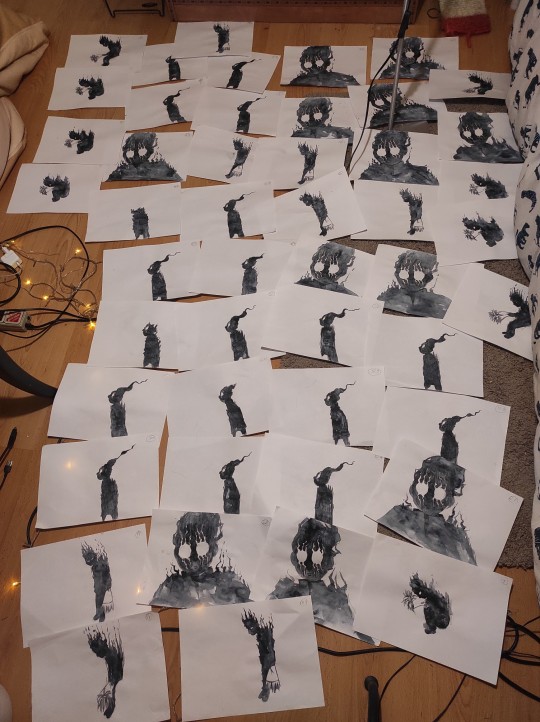
the frames for that mob animation (including some that i made but ended up not using) take up most of the floor in my room lol
#btw the backstory for this was that i wanted to make an animated tribute for mob's finale#but i was animating for my grad film and looking at screens all the time and my eyes were tired#so i decided to do something traditional#i liked the experience a lot i want to do it again.... im bad with colored watercolors tho so we'll see#its me talking#my art#edit: i looked again and im actually missing some damn
43 notes
·
View notes
Note
assuming they were normal citizens of the world, what kind of ig users do you think svt would be? like who would post stores about you all the time, who would soft launch you, who would only post during anniversaries, who would post cheesy ass things, who wouldn’t post you until y’all are engaged, etc lol. thank you! 😍
i feel like some of these still have an air of fame to them… like some of this shit fans would eat up/they have a feeling of being shared with an audience of strangers
seungcheol: he posts adorable videos of you that make everyone swoon. the most recent is you barefoot at his cousin’s wedding reception dancing in the grass with a glass of champagne in hand. you look heavenly, and his captured ooos and laughter are heart melting. in the corner of every video posted is a little *i have consent to share* because in some clips, it’s clear that you have no idea he’s filming, and that makes them even sweeter
jeonghan: you’re a complete weirdo, and he’s so amused. he doesn’t document all the wacky shit you do, but some of the best moments make it to his instagram
joshua: the only time you’re on his social media is when you’re driving and singing pocketful of sunshine. it’s basically your version of sunday morning
jun: he has a highlight dedicated to everything you bake, and he does wholesome zoom ins with the perfect background music
soonyoung: he’s documenting his life on social media but is respectful of your disinterest in being perceived, so your face is rarely shown. captured conversations are always amusing because the camera is focused on his expressions, and he always :] when you ask if he’s recording
wonwoo: he has a story dedicated to the summary screen when you’re gaming together, keeping track of wins, and adding cute emojis whenever you beat him atta girl
jihoon: he has an anime highlight where you share ratings and recommendations. you’ve probably started an anime commentary podcast together
seokmin: he’s dating a musician (cello player) and has a highlight dedicated to your recitals. every evening of a show brings the same trio of pictures: a flower bouquet held in his hand + i hope she’ll like it, you on stage, and one of him hugging you afterward backstage. so fucking adorable and the captions are so wholesome: “i’m the proudest boyfriend” “🥺🥺😭😭❤️❤️😘🖤🤧😍🫠” “everyone stared at me when i whistled from the first row, but i don’t even care”
mingyu: almost every picture he posts was taken by you, and he makes hearts melt with captions like “taken by my love” or “she did good, huh?” someone stop him
minghao: he met you at a yoga studio because you’re an instructor, and classes at dawn end as the sun rises. he always shares that moment on a monday as vibrant colors consume the sky, starting off his week right, and sends good vibes to followers
seungkwan: he posts pictures of you flipping him off at the dining room table—it’s an ongoing saga—because you haven’t had your coffee yet. we’re two peas in a pod. you film videos of him running, calling out encouraging words, and promising to give him a massage afterward even though he’ll want a donut instead
hansol: he alludes to having a significant other but is never forthcoming. the pieces come together quite easily because of his flirty replies to your comments, and any time he travels the location is the same because you’re long distance. the reveal comes when you’re graduating from grad school, and he posts candids fixing your cap, kissing your cheek, and beaming as he embraces you.
chan: even as a normal citizen, there’s no way this man wouldn’t be dancing, and you always bring meals to the studio, so he posts pictures of the impressive spread before eating. he’s quite public about his relationship. also posts pictures of you strolling through the farmers market, along with posts of you wearing matching bunny headbands featuring green face masks
#seventeen scenarios#seventeen reactions#seventeen imagines#seventeen blurbs#seventeen fluff#seungcheol scenarios#jeonghan scenarios#joshua scenarios#jun scenarios#soonyoung scenarios#wonwoo scenarios#jihoon scenarios#seokmin scenarios#mingyu scenarios#minghao scenarios#seungkwan scenarios#hansol scenarios#chan scenarios
440 notes
·
View notes
Text
i survived my first week of grad school!! (!!!!!!!!!!!!) moments:
scenic design is super technical and part of me knew that and factored that into why i decided to go to school for it BUT all this dealing with “real life” is making me miss animation lol so i’m trying to reengage that part of mahself
my roommate is definitely an ST and it’s influencing how i organize my thoughts...
on the other hand my cohort-mates are super N so that helps recalibrate me
my department head is like Kirk from Gilmore Girls, he works every job and taught almost all of my classes this week to make up for one lost professor and one very-far-away professor
the Invisible Cities assignment made me realize i’m very into the concept of “thin” designs, like spaces that are elementally sparse
scenic painting is separate from scenic tech (revelation 1), and it is SUPER badass (revelation 2)
did you know that the really good paint bristles used to be made with Russian boar hide, which was (more?) ethical because Russian boars naturally shed their hair? but during the Bolshevik Revolution they were killed off for their meat, and now we get our bristles from boars that are factory farmed
need to look up: whether conserving water in one state actually helps those who are experiencing drought in other states since idt states necessarily share water sources??
money still weighs heavy on my mind but i need to remember to contain that anxiety cuz i want to fully flood the senses with this art school experience
but i also gotta figure out how to have a life outside of school, too, since i used to do art things in my free time and now my regular time is art...
there are abundant film screenings and performances to be seen at school and i can go to all of them for free (T_T)
i think i need to learn how to work more slowly and thoughtfully, i kind of rushed through my lettering assignment
we’ve been really making our studio space suitable for those intensive all-nighters; J ordered a dog bed for the space under her work desk and is going to hang up curtains and string lights for ~max coziness~
i ordered udon and cup noodles and aromas and Milkis to sweeten my little corner, which is positioned so perfectly that i can’t really see anyone in my periphery unless i actively try
i very thirstily reached out to meet with my advisor and i don’t feel bad about it...yet
i had some really nice FaceTimes this week and it made me remember that i’ve got to work hard to maintain the connections i’ve made because they make me happy and fulfilled and more ready to take on this new life here
i’m really enjoying so much of it so far (>.<) *knock on wood*
0 notes
Text
LGBTQ+ Movies I Watched Recently (Part 2)
Happiest Season (2020)
dir. Clea DuVall

Short Summary: Abby plans on proposing to Harper when they visit Harper’s family for the holidays. Her plans get derailed when she learns that Harper hasn’t come out to her family yet.
Why you should watch it: Not gonna lie, Mackenzie Davis drew me to this movie; I’ve been in love with her ever since San Junipero came out. Add Kristen Stewart, Aubrey Plaza and Dan Levy to the mix and I’m sold. If you want a sapphic romance with a happy ending, this one’s for you.
Été 85 (2020)
dir. François Ozon
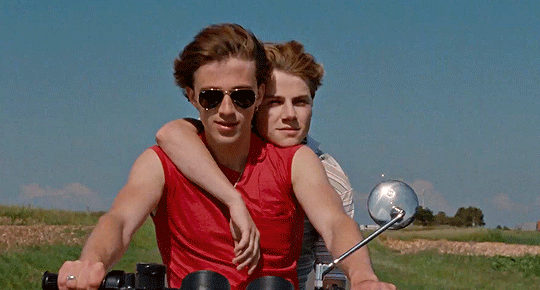
Short Summary: Alexis recounts his six-week love affair with David during the summer of ‘85.
Why you should watch it: If you love 80s aesthetic and music, you definitely should watch this. The movie made me nostalgic of that decade and I wasn’t even alive back then! It’s a whirlwind summer romance reminiscent of Call Me by Your Name but with a more devastating twist.
Getting Go: The Go Doc Project (2013)
dir. Cory James Krueckeberg

Short Summary: An obsessed college boy pursues his internet crush through the pretext of making a documentary about him.
Why you should watch it: The script and the acting are the one-two punch of this film. The writing is incredibly genuine, and both of the actors’ performances made the lines feel even more natural. I’m not the biggest fan of mockumentary-style films, but this one felt like it was a recording of my own life. Hyper-obsessive college grad with a Tumblr blog? Might as well have called out half the population of this damn site.
Pihalla (2017)
dir. Nils-Erik Ekblom
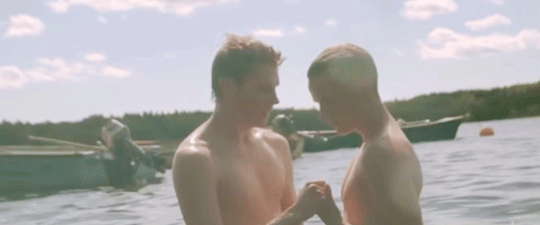
Short Summary: Miku and Elias find themselves, and each other, during a summer in the Finnish countryside.
Why you should watch it: I’m a sucker for gays in the countryside™ and although this one is not quite up there with God’s Own Country and Call Me by Your Name, it still makes for a good watch. Miku as a character and his relationship with his parents was chaotic and fun. His relationship with Elias felt really natural and dreamy.
You, Me and Him (2017)
dir. Daisy Aitkens
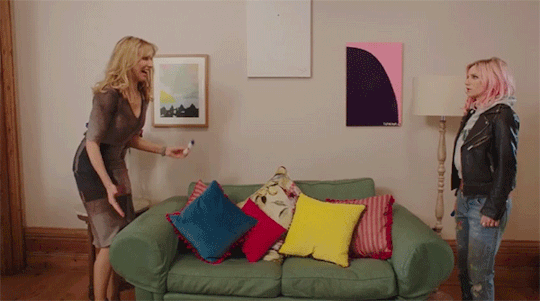
Short Summary: Olivia, a mature responsible lawyer, wants to have a baby, but her girlfriend Alex isn’t ready for the responsibility. Things get even more complicated when their flirty neighbour, John, joins the picture.
Why you should watch it: It is one of the most feel-good lesbian romcoms I have seen in a while. But I warn you, there are some dark parts that can really sneak up on you. Yeah, it’s hilarious, but damn it made me ugly cry, too. Oh, and if you want to see David Tennant as an alpha male douchebag, here’s your chance. (CW: **spoiler alert** p̶r̶e̶g̶n̶a̶n̶c̶y̶ ̶l̶o̶s̶s̶ )
Giant Little Ones (2018)
dir. Keith Behrman
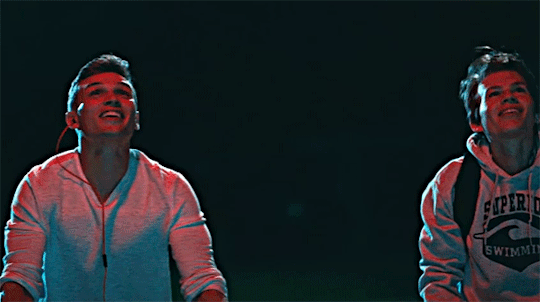
Short Summary: Franky and Ballas have been best friends since childhood, both on the swimming team, both incredibly popular. But after an incident during Franky’s birthday, they quickly fall apart and Franky falls from grace.
Why you should watch it: I think the film captures just how tumultuous coming-of-age stories are. Franky is going through his own journey of self-identity, and I’m happy that the movie didn’t rush in with labels. The conversation Franky has with his dad at the end also hits hard. (CW: physical assault, allusions to sexual assault)
Our Love Story (2016)
dir. HyunJu Lee

Short Summary: A fine arts student meets an attractive bartender, and the two women begin an intimate relationship.
Why you should watch it: It’s a very intimate love story that isn’t rushed or dragged out for too long. We definitely see Yoon-Jo and Ji-Soo’s relationship bloom from start to end, but it’s not mind-numbingly boring to watch. Raw and unembellished, I definitely recommend this to anyone looking for a realistic portrayal of wlw romance.
Die Mitte der Welt (2016)
dir. Jakob M. Erwa

Short Summary: The film follows Phil and his relationship with his family, his best friend, and a newcomer at his school, Nicholas.
Why you should watch it: This is technically a second watch for me, and I’m glad I rewatched it, because I was able to catch some glaring red flags that I missed the first time. I love this movie in spite of all the heartache it caused me. The story, especially the deal with Phil’s family, struck a chord in me. And the shots! Visually stunning as well!
Les Amours Imaginaires (2010)
dir. Xavier Dolan
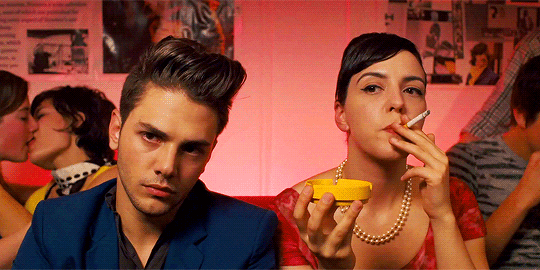
Short Summary: Marie and Francis’ friendship is put to the test when a beautiful boy called Nicolas comes between them.
Why you should watch it: Watch it for the visuals -- the colors, the costumes, the cast. Seriously, the actors included here may as well be kept in the Louvre: Xavier Dolan, Neils Schneider, Monia Chokri, hell, even a cameo from Louis Garrel! Dolan said it himself that this is a shallow film, but it’s worth the watch just to see Neils Schneider wearing heart-shaped glasses.
Closet Monster (2015)
dir. Stephen Dunn
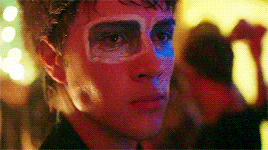
Short Summary: A creative and driven teenager is desperate to escape his hometown and the haunting memories of his turbulent childhood.
Why you should watch it: Right off the bat, I am going to say that this film is dark. I tried watching it back in college but tapped out within the first ten minutes because something traumatic happens. Then I tried again about a week ago, finished it this time. It’s actually a very moving film. It’s violent and gory in some parts, but also ridiculous and wholesome in other parts. IT HAS A TALKING HAMSTER NAMED BUFFY! BUFFY WAS THE STAR OF THIS MOVIE FOR ME. (CW: gay bashing/sexual assault)
Straight Up (2020)
dir. James Sweeney
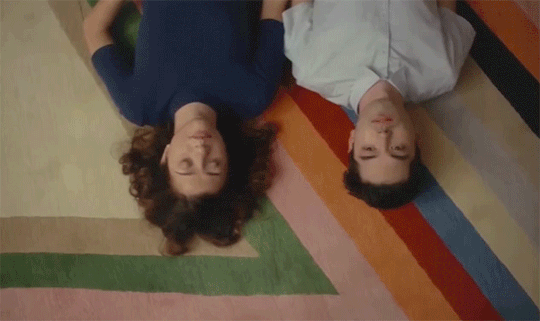
Short Summary: Todd and Rory are intellectual soul mates. He might be gay but she might not care.
Why you should watch it: The dialogue in this film is undeniably sharp and witty. Loved the fast-paced back and forth between the two main characters as they discuss relationships, sex, gender, and more. James Sweeney and Katie Findlay’s chemistry just pulled you into the screen. It was funny, it was sweet, it was heartwrenching, it was great! (CW: allusions to sexual assault)
Latter Days (2003)
dir. C. Jay Cox

Short Summary: A promiscuous gay party animal falls for a young Mormon missionary, leading to crisis, cliché, and catastrophe.
Why you should watch it: I saw this in santiagonex’s top 20 LGBTQ+ films with happy endings, and I honestly thought it was gonna be a feel-good watch. Instead, I got a rollercoaster melodrama filled with early 2000s gay culture, religious guilt, buttcheeks, and Joseph Gordon-Levitt. Needless to say, I got more than I bargained for. (CW: self-harm, conversion therapy)
The Old Guard (2020)
dir. Gina Prince-Blythewood

Short Summary: A covert team of immortal mercenaries are suddenly exposed and must now fight to keep their identity a secret just as an unexpected new member is discovered.
Why you should watch it: Okay, I was debating whether I should include this here, because it’s not necessarily an LGBTQ+ film as much as it is an action film with queer characters. I decided to include it, because JESUS! I have never seen such respectful and well-written representation of queer characters and relationships. Joe and Nicky are the most unproblematic couple in history. PERIOD. Pray for sequels, everyone. This is the kind of representation we deserve in mainstream media.
. . .
Click here for more LGBTQ+ film recs
#Queer Cinema#queer films#LGBT Films#lgbtq#Movie Recommendation#kristen stewart#mackenzie davis#summer of 85#the old guard
228 notes
·
View notes
Text
Godzilla Singular Point
I came into Singular Point with some trepidation because Godzilla’s history in anime is both very recent and extremely bad. The three anime movies released between 2017 and 2019 are easily the worst work of famed writer Gen Urobuchi and honestly contain more bullshit than I can even get into here. Those movies and this series were both Godzilla anime properties commissioned by Netflix, which didn’t get my hopes up very much. Thankfully, Singular Point is a very different beast from the anime trilogy. One could argue it’s very different from most Godzilla media, actually — at least from my perspective. And I’m still a pretty entry-level fan of Toho’s Big G, all things considered.

Let me just warn you right up front: This smartphone-based virtual assistant is basically the breakout star of the series.
When you think “Godzilla,” you probably don’t think “incredibly dense sci-fi concepts,” but with the big G’s first-ever anime series, the writers clearly set out to change that perception. Before the first kaiju even appears, the lead characters are plucked from obscurity and dropped into a mystery that involves fourth-dimensional time travel, physical objects that look different from all sides, theoretical math concepts, self-propagating A.I., and a whole lot more. And it’s NEVER made clear how all of it connects to the rampaging kaiju! Although we spend a lot of time investigating a red dust or sand that is very obviously tied to the monsters in SOME way, no one ever makes a connection that explains the relationship. Maybe we’re supposed to wait for a later season to connect the threads... but let’s get into the idea of “another season” later.
I like to think of myself as someone who typically enjoys hard sci-fi, but even with the characters spending loads of time trying to explain the high concepts driving the story, I was never able to fully wrap my head around what was going on in the mystery at the center of GSP. I rewound and rewatched a few explanations, but I still walked away feeling lost. I eventually settled on some vague, loose understandings of most of the ideas mentioned, but those understandings were subject to being ripped apart in subsequent scenes when I was shown or told something completely at odds with what I thought I knew. I can’t say I was ever bored with the thick, dense scientific concepts on offer — trying to find purchase with these far-out ideas kept me glued to the screen — but damn, I sure wish I was able to comprehend them.

What do we want?! DENSE SCIENTIFIC DISCUSSION AND DEBATE! When do we want it?! AFTER THOROUGH RESEARCH, TESTING, AND PEER REVIEW!
Another weird thing about this show is that the lead characters remain in separate locations and on separate tracks for the entire duration. We have Yun — a mechanical engineer and programmer who has an amazing grasp on physics and human behavior. And we have Mei — a grad student who is deeply invested in theoretical science, UMAs, cryptids and other far-flung concepts. Both of them are basically geniuses in their fields, and even though they take opposing views of just how flexible reality is, their shared ability to think “outside the box” becomes the crucial component in solving the mystery at the core of the series. Because they don’t even know one another (despite being separated by like, ONE degree), they only ever interact via text messages and behind screen names, which feels pretty damn weird. At least I immediately liked both of them, with Yun being the standout to me because of how his lowkey reactions to crazy shit generates a lot of humor.
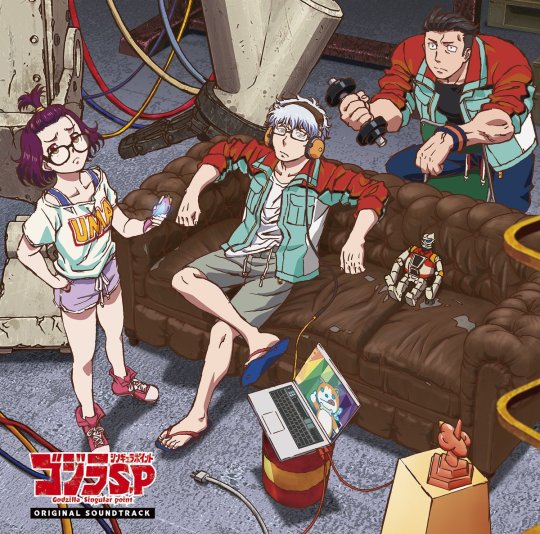
This soundtrack cover LIES; you will never see these characters in a room together like this.
Alas, we don’t get to know the characters a whole lot beyond what we learned of them in the first two episodes. It’s not long before they’re trapped in a series of complicated exposition dumps, endlessly attempting to explain the high concepts of the show to other characters as well as my dumb ass in the audience. The fact that I liked them in the first couple of episodes carried me through more than half of the show, but I was always hoping to see them share more of themselves or just display more emotion. Anime as a medium excels at emotional storytelling. But despite the major, world-altering events the characters are constantly warning us about, none of them seem to have many emotions about said events.
Further complicating matters is how, when major events finally occur in this show, they are often kept off-screen. One character shockingly dies, but the portrayal of that death is so piss-poor that I didn’t even realize it’d happened until someone mentioned their death in the next episode. After that vague death, I was particularly sensitive to anything that looked like it might possibly be lethal. Yet a later event that is played up as a tragic, fatal occurrence ends up... fine, somehow? It’s not clear how the character survives, because — even after one of our heroes is left screaming their name in despair as they seemingly die — nobody ever talks about or explains how he’s just fine a couple of scenes later. And near the end of the series, there’s a major transformation that occurs for one of the characters, and we never see it happen nor do we understand HOW it happened. It’s just that suddenly, this character is extremely different due to off-screen reasons that are only vaguely verbalized.
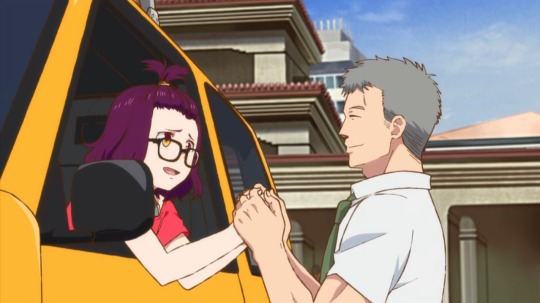
I guess these two really bonded at some point for some reason? And what you are seeing here is literally the height of emotion shown in the entire show.
Even though the overarching story of the series so far pretty clearly wraps up in episode 13, we then get a post-credits tease for a potential second season. So the question becomes: Would I watch that?
Well... Godzilla Singular Point is a series with a lot of issues that kept me at arms’ length from it — tons of extremely confusing dialogue, highly frustrating choices in direction that lead to baffling storytelling, characters who are mostly exposition-dumping — and yet there’s still some foundational work here that I appreciated a lot. When the action occurs, it’s pretty cool/fun. And when urban destruction occurs, it can be awe-inspiring. The human characters, though little-explored, have likable and interesting foundations to them that could be expanded upon. And I didn’t even mention the soundtrack, which features a variety of musical styles combined with the classic Ifukube theme music and an OP that is an absolute banger. (I have a weakness when it comes to music; a good soundtrack can carry me through even the blandest series sometimes.) Even the core idea of centering a Godzilla series around hard science and mathematical concepts is a compelling one, I think! I just hated the execution of it; they went waaaaay too far on poorly explaining incredibly complex, mind-bending concepts for my pea brain to handle it. They spend so much time trying to explain things, yet somehow they never succeeded for me.
Ultimately, I’d probably give the show another chance. But if I do give another season a chance, it’ll be on probation. I wouldn’t watch the entire season unless I could see within four episodes that they’d definitely improved things.
Would I recommend that anyone watch the series as it currently stands? I mean... not really? I guess if you really dig complex math, hard theoretical science, and/or Toho’s stable of monsters, then maaaaaaaaaaybe give it a shot. But otherwise? Naaaahh. It’s not good enough at anything to make it stand out from the anime crowd. I didn’t hate it like I hated the Godzilla anime films, but Singular Point is still something that both casual viewers and most fans can comfortably ignore for the time being. It’s not a complete disaster, and it’s not without its highlights... but it’s definitely disappointing in my opinion.
OKAYOKAYOKAY, so let’s talk about the kaiju for a bit!
Below will be SPOILERS revealing all of the kaiju that appear in Godzilla Singular Point and giving my feelings on them.
Godzilla — It’s interesting to see a version of Godzilla that borrows some ideas from Shin Godzilla. Shin G has been incredibly unique until now, but this Godzilla manages to fold some of Shin’s distinctive aspects in with the more classic/typical versions to build a fun new depiction. Be forewarned that Godzilla doesn’t show up until the series is halfway over, and he doesn’t get a ton of screen time, either. He’s used quite sparingly and kept in hazy settings, often framed from the neck-up when they show him. It’s a little frustrating that they felt the need to shroud him so much, but I respect the fact that whenever Godzilla is shown, the destruction he causes is on a scale far beyond anything that the rest of the kaiju ever do. He is pure devastation.
Rodan — He’s easily the biological kaiju with the most screen time in Singular Point. Rodan is first introduced as one gigantic pterosaur, but if you’ve seen ANY trailers for this show then you already know that his depiction transitions into an asston of smaller pterosaurs, all of whom are also called “Rodan.” (Apparently the word Rodan is both singular and plural, like the word “buffalo.”) Although he looks kind of cool at first, pretty soon Rodan showing up isn’t special or threatening anymore. Rodan appearances go from “a big goddamn deal” to “some bland background noise” before the series is even 1/3 finished. The design might be a little too far removed from the original for my own taste, but even if I didn’t think that, I wouldn’t be able to care for this Rodan simply because he’s rendered so unimportant and unimpressive.
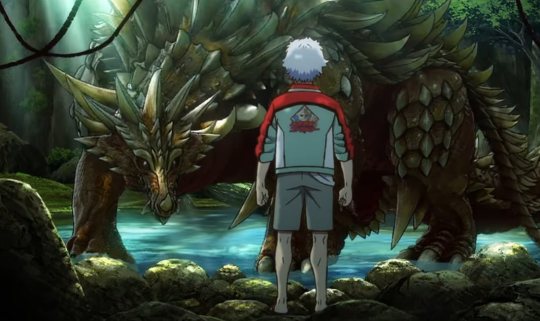
If you go out in the woods today, you’re sure of a big surprise...
Anguirus — Now check this guy out! Anguirus gets one of the coolest fights in the show and also demonstrates some powers that are well beyond anything we’ve seen him do before. Because he sticks to unpopulated areas, we never see him do much damage to Japan, but he is definitely holding all the attention when he’s on-screen. He’s a highlight for me — a total badass who is very unique in his abilities. And the stated origin for his name is goddamn adorable.
Manda — Yup, Manda is in this series... but I don’t have much to say for him. It seems like the creators of the anime didn’t have much to say about him either. His role amounts to little more than a repeated cameo, and in most of those cameos you only ever see his tail. When we finally see his full body, it’s done so briefly and kept at a distance, leaving me with no real impression. I had to look up his design online and... yup, that sure looks like Manda. Final score: MEEEEHH.
Kumonga — I definitely did not see this appearance coming! Kumonga is much smaller here than you may be used to, but she gets to star in the most suspenseful sequence in the series and easily earns the most exciting cliffhanger moment at the end of an episode. I was utterly glued to the show during her screen time, which comes with a lot of icky twists. Good ones! I honestly like Kumonga here more than I ever have previously.
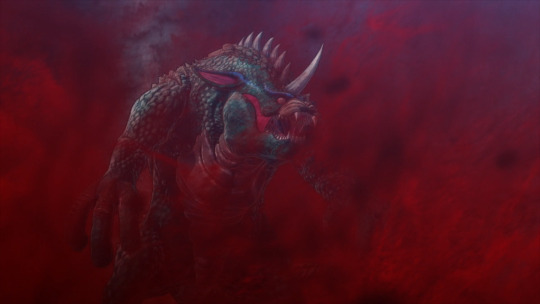
NEW PHONE WHO DIS
Salunga — Uh, who? This is the one monster that isn’t based on a classic Toho kaiju but instead is a brand-new creation. I suppose that everybody who touches the Toho Kaiju franchise wants to make their own mark on it in some regard. But a big part of the fun of this series for me personally was the anticipation of seeing new interpretations and designs of classic Toho monsters. And so, given that he kind of resembles both Baragon and Gabara, I never stopped wishing they’d just used one of those guys as the basis and namesake. Taken on his own, however? He’s... pretty neat. Not unique or exciting, but solidly above par. He resembles a cross between a lizard/dinosaur and an ape, plus his head has some nifty coloration.

Our Jaguar!
Jet Jaguar — I guess Jet Jaguar isn’t exactly a kaiju in the traditional sense because he’s a Giant Robot. However, if you want to consider him one, then I wager he probably gets even more screen time than Rodan! We meet him almost immediately when the series begins. Initially an odd pilot-driven robot that was constructed at the whim of a quirky old factory-owner with too much disposable income, Jet Jaguar grows and changes over the course of the show, ultimately undergoing a transition in episode 7 that makes him pretty damn impossible to dislike. In fact, I utterly adored him by then. This is definitely the best Jet Jaguar I’ve ever seen. His design is recognizably similar to the original yet utterly distinct, too. Like many of the other kaiju here, he’s not nearly as big as he was when he was first introduced to the movies, but his size is ideal for battling the smaller-scale monsters that we spend most of the series on.
9 notes
·
View notes
Text
These are disruptive gang members.
These are disruptive gang members. Ceramic glass has a higher thermal shock rating than tempered glass, at approximately 1400F. He has lived too long, she tried to tell herself. A highborn king of pure Ghiscari blood could reconcile the city to your rule. "Republicans in the Legislature have effectively knee capped Rubio's chances of obtaining the nomination and they have no one to blame but themselves. A small percentage of people infected with Salmonella Paratyphi C carry the bacterium without falling ill, so apparently healthy Spaniards could have infected Mexicans who lacked natural resistance.. In addition to a Christian education, his children learned first hand the basic principle of running a small business: hard work. Ignorant words from an ignorant person. Direct Canadian service has been one of our top priorities for some time now and it is rewarding to see that our hard work has finally paid off, said Greg Kelly, airport executive director. Doherty is not going to pose any problems for batsmen and could hardly get a game. Jan Williams of Whittier lost her son, 27 year old Neal Williams, and her two grandsons Ian, 3, and Devon, 7, when Neal William's wife, Manling Williams, allegedly killed her husband with a sword and smothered the children at their Rowland Heights apartment in August of 2007. He did not have to like it, though. “He hoped I would not come here, so that he might go to her, and say afterwards that he was in the right, that he told me beforehand I wouldn’t, and I didn’t. That's the key.". Blinded cause I am only a man. I had noticed before that at some moments he seemed, as it were, forgetful, forgot for instance that he was not alone in the room, and would talk to himself, gesticulating with polo raflorenehis hands. There will be a Four man team format at a cost of $65 each. But the old man did not know whether he would have the strength to endure fresh insults. Love always passes, but incompatibility remains for ever. Stannis Baratheon had smashed Mance Rayder’s host and made the King-Beyond-the-Wall his captive … but the wildlings were still out there, the
bocanci grisport 480
Weeper and Tormund Giantsbane and thousands more.. The Short Films and Feature Animation Branch Reviewing Committee viewed all the eligible entries for the preliminary round of voting in screenings held in New York and Los Angeles and their members will now select the five nominees from among the 10 titles on the shortlist. Lots of documentaries use voiceovers and professionals to fill in the gaps, to explain to the audience what going on, or perhaps to outline historical significance of one event or another. On the verge of classical acting studies in London, England, the local son and UVic acting grad demonstrates a powerful grasp of the retros kabátok discipline. Bubnov’s, and two llantas 4x4 online days later we moved, and the captain’s widow with us; and after we’d moved mother was quite ill and in bed for three weeks, and I looked after her. From all we can learn, the only evidence relied on by the prosecution was that white man employed by the Castlemans. Vassilyevskoe was mortgaged over and over again. He has pig eyes, Asha thought. For advancing certain sentiments on these topics, Mr. She said she’d let some kneeler marry her and never slit his throat if only Mance could live. Walk in our shoes; the truth is many of those who say they hate us are only one paycheck away from being homeless. Some struck home. “You must excuse me, Captain-General. He got smacked in the face by an official in mid signal and was penalized 15 yards for "physical interference." That was a debatable call. Builders can swap this fan for a 120 mm radiator, but a 140 mm heat exchanger won't fit. Filip Filippovitch told me to. Not only are most residents of Mexican descent, but the economies on either side of the border share mutual interests. Though camara sony cybershot dsc w810 chaussettes bon marché he’s a scoundrel (to my thinking there’s no man who isn’t) he’s not a scoundrel in his dealings with you. Mr. Now, she enjoys being able to put on the show for others to enjoy.. "Your gun is only is good as your scope," Adams said. pantofi sport tip soseta dama The 740 boasts 6.7" (170 mm) of space for tower style heatsinks, 240 mm or 280 mm radiator mounts on its top and bottom panels, and a 280 mm or 360 mm radiator mount on its front panel. The stub of his nose itched horribly, but his arms were pinned so tightly that he could not reach to scratch it. Other types of movements, such as the swaying of the heroine dress in Tangled, are based on a similar set of algorithms.. "After the health scare he went through, he's able to share with our kids how fortunate they are to be here, let alone compete in the sport they want to compete in. Ser Barristan retreated. He shall see now whether I’m feather-headed. She was the wife of the late Harry M. After laying out the material, the batteria ai polimeri di litio amazon wool is put in water and agitated with soap by either rubbing it or rolling it. Carl, a NE style IPA is maltier and like all NE styles, cloudy. SEMENTARA itu, Rencana Dewan Adat Papua (DAP) untuk mengembalikan Otsus kepada pihak pemerintah lantaran dicap gagal pada 12 Agustus besok, nampaknya telah menimbulkan pro dan kontra. The back of the hall was a solid press of people, and scuffles broke out over precedence. “I have hostages, on Harlaw,” she reminded him. Trip back in fashion time was part of a theme the library kept going for its One Book / One Community discussions through the county libraries. Perhaps Hizdahr was wiser than he knew. "Andrew then wanted me to drink salt water. Linemen_Jacob Burley, Lancaster Fisher Cath., 6 4, 260, sr.; Jacob Spencer, Shadyside, 5 10, 285, sr.; Alec Romesberg, Mathews, 6 1, 245, jr.; Gavin Cupp, Leipsic, 6 6, 280, sr. What's he looking up at?) He is followed by a second person, who follows suit. 27, and he said there has been precedent for a top flight player to be left off the roster because of high school ineligibility. The banker doffed his hat and made a sweeping bow. Suddenly he hit the papuci de casa din pasla steps with his stick, ran and opened his door, and a minute later brought me out some coppers and threw them to me on the stairs.. The General Assembly met. "One of the kids who got a bicycle from us, (Maximo) Wyatt, was hit while he was riding with his father and almost killed. His eyes were grey and greedy, his teeth yellow, his forked beard a tangle of snow and silver. Infinity lay between us. As Sue sees it, something almost magical happens when Gemma dons her dancing shoes and steps out with partner Sheldon Gilbert, with whom she has won several major competitions in Victoria and interstate."It is the most amazing thing," she says. 2. The piranha that has blood plate big mouth, canine teeth as well as horror eyes was taken into calça kickboxing consideration of the design theme of the latest custom paragraph. The list includes buying only shoes with good padding at the balls of the foot and a gradual slope (rather than the 90 degree angle shown in his X ray), so the force is more evenly distributed over the foot.. “Even the smallest scratch can prove mortal, lord Captain, but if you will allow me, I will heal this.
1 note
·
View note
Photo


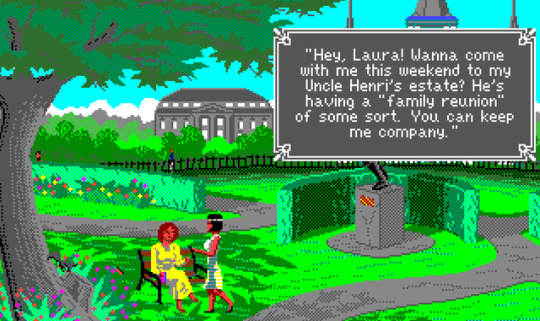

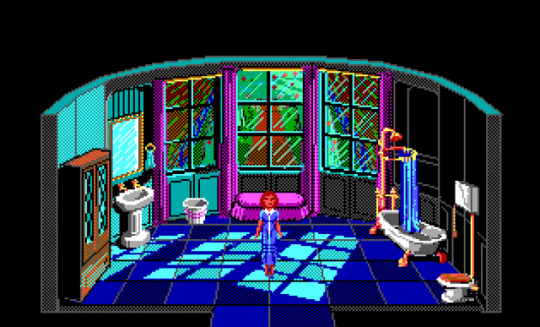


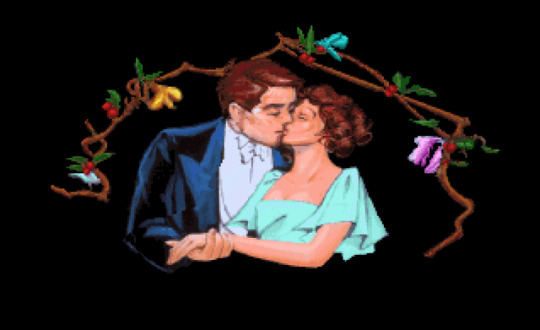


The deductive point ‘n click escapades of a forgotten southern belle
Adventure games of the point ‘n click variety are a genre that tend to feature female protagonists more often than others. Why this is the case, I’m not entirely sure - it might have something to do with the stereotype that women are more patient, more willing to read and perhaps better at solving puzzles than men. Or, perhaps legendary adventure game designer Roberta Williams’ influence still holds strong, at least on a subconscious level in the minds of designers, over the genre that she helped nourish in the 80s and 90s, and the heroines of today’s games are merely following in the footsteps of fine women that preceded them, like Rosella of Daventry in King’s Quest IV.
Whatever the reason, despite there being quite a few point ‘n clickers popping up these days with engaging female protagonists (Kathy Rain is one that I played early this year and enjoyed), there’s a 1920s southern belle who probably deserved a long-lasting series but only got two games which are somewhat overlooked these days. Her name is Laura Bow, and she served as the protagonist of two Sierra titles that were released in 1989 and 1992 - The Colonel’s Bequest and The Dagger of Amon Ra.
Laura seems to have been specifically patterned after famous silent film actress Clara Bow, but at her heart she’s more like a slightly older version of Nancy Drew, and her two games embody Nancy’s fine tradition of mystery solving. The Colonel’s Bequest takes place on a private island in the bayous of New Orleans as Laura accompanies a friend and fellow Tulane University student for a weekend getaway at the manor of her uncle, Colonel Dijon. The old man is bequeathing his fortune to relatives and has invited a motley assortment of characters right out of an Agatha Christie paperback - the drunk aunt, the conceited Hollywood starlet, the perverted doctor who seems to have a thing for betting on the ponies - and a la Clue, bodies start piling up as the relatives presumably begin offing themselves in order to get Dijon’s fortune first.
I mentioned Roberta Williams previously, and The Colonel’s Bequest was actually designed by her as one of those rare side projects that didn’t feature the words “King’s” and “Quest” in the title. (Hm, I suppose it’s called The Colonel’s Bequest, so scratch that.) It’s always hard to tell how much Roberta was involved in non-King’s Quest projects - The Dagger of Amon Ra, for instance, was directed by Bruce Balfour despite featuring her name on the box - but I’d wager that she intended The Colonel’s Bequest to be a spiritual remake of her very first adventure game (and indeed, the first graphical adventure game ever), Mystery House. Mystery House featured a similar murder plot, and The Colonel’s Bequest takes this concept and evolves it, offering a unique structure where there aren’t really any puzzles to solve but instead “scenes” to witness. The entire game is structured like a play - there’s even a cast curtain call in the beginning - and Laura is encouraged to spend as much time as possible talking with the potential murder suspects and finding unique ways to eavesdrop on them.
The game’s manual makes a huge deal about this emphasis on observing the story and slowly figuring out the links between characters in an effort to deduce the killer, and we can look at Johnny L. Wilson’s 1990 review of the game in Computer Gaming World as an example of how this approach was seen as admirable, fresh and also a bit risky at the time. Don’t let the fact that there aren’t many puzzles fool you into thinking that The Colonel’s Bequest is easy, though - it’s just as tough as Sierra’s other adventures with just as many nonsensical ways to die, and the unique structure where certain events and conversations are “timed” (indicated on screen by a clock) means that sometimes you’ll be wandering around aimlessly searching for the next thing to do, or possibly miss out on vital bits of info because you weren’t at the right place at the right time. It’s a little like The Last Express, only less refined.
Luckily, the game’s great atmosphere makes up for any shortcomings that its boldly unorthodox but occasionally clunky design creates. This is one of the best 16 color titles that Sierra produced with their SC10 engine, and the soundtrack is packed with jazzy songs influenced by the Roaring Twenties with just enough sense to know when to be quiet as well. As you navigate Laura across the silent grounds of the mansion in the dead of night, wondering where the killer might be, it’s very possible to get shaken by the sound of lightning bursting in the background, and I can certainly imagine young players in 1989 jumping out of their skin when they encountered such moments.
Laura’s next outing, The Dagger of Amon Ra, trades the dark island setting for the Egyptology craze of the 20s, and loses a little bit in the process but makes up for it with 256 colors, rotoscoped animations (which are darn smooth but cause character sprites to be a bit muddy, unfortunately) and an even catchier selection of jazz tunes, including an amusing vocal track called “The Archaeologist Song.” Oh, and the CD version is a “talkie” game, with performances that range from kinda terrible (Sierra was still having their employees voice these games at the time instead of hiring actors) to excellent (Laura’s got a cute southern accent and the narrator’s voice is heavenly).
The plot revolves around the titular Dagger of Amon Ra, an Egyptian artifact that’s been stolen from a New York City museum. Laura, now a fresh grad from Tulane and in the middle of her first journalism assignment at an NYC paper, has to navigate the mean streets of Manhattan, infiltrate a speakeasy and chat with a mildly racist caricature of a Chinese laundromat owner before getting into the museum, where she once again encounters a wide cast of characters, from the stuck up British twat who removed the dagger from Egypt to the nutty countess, who is possibly engaged in some mild robbery efforts around the museum when nobody’s looking. People start dying pretty soon (and their death scenes are grand - check out this poor SOB who got decapitated and stuck with a Perodactyl beak) and while the beginning section of the game outside of the museum is more like a traditional point ‘n click affair, once you’re locked inside the building after the first murder, everything becomes reminiscent of The Colonel’s Bequest. You’ve got to meander about, hope you bumble upon the right conversations and try your best to piece together clues before the murderer suddenly starts chasing you during the game’s second-to-last chapter.
The Dagger of Amon Ra kind of stumbles in its execution of this form of gameplay more than its predecessor, because all the chapters of museum exploration feel terribly disjointed even more than walking around Colonel Dijon’s mansion did. Also, the character motivations are unclear, which is a problem in a mystery game - especially one where the entire final chapter actually involves Laura being quizzed by the coroner in an annoying game of 20 Questions as to the identity and motives of the killer! If you slip up once during this finale, you’ll get the bad ending, which involves the killer finding Laura’s apartment and GUNNING HER IN HER SLEEP, jinkies. And even if you succeed and get the good ending, which sees Laura writing her first award-winning expose on the theft and hooking up with putzy love interest Steve Dorian, it’s still quite impossible to discern the killer’s motives and why he went about his nefarious deeds, because The Dagger of Amon Ra just...doesn’t explain things. I’m not the only one who had trouble figuring it out - The Adventure Gamer blog wrote up a fantastic series of posts about this game and came to the same confused reaction as I did.
Both Laura Bow adventures come from an older time where it was common to take notes as you went through a game, so perhaps my puzzlement at The Dagger of Amon Ra’s ending is due to my lack of pencil and paper by my side as I played. I did use walkthroughs for both games, though, and if you do end up checking them out (they’re available on GOG), I’d recommend doing the same. You probably still won’t be able to figure out why whatshisname stole that dagger, but despite their flaws, the Laura Bow games really are worth experiencing. Laura’s a likeable lead (just look at this adorable expression on her face as she stumbles upon the museum’s French skank engaged in hanky panky with the janitor) and she does a fine job of showing off the spirit of the 20s, an underrepresented period in the pantheon of electronic gaming.
Laura never got a third game, and as far as mystery franchises go, Sierra soon passed the torch to the Gabriel Knight series, which apparently takes place in the same universe, since Gabriel visits Tulane in Sins of the Fathers and hears word of a lecture being given by “Laura Bow Dorian” - a hint that Laura married Steve Dorian and lived happily ever after! I’m glad that Ms. Bow got a nice ending even if we couldn’t see it in game form, and I’m sure that if she were a real person, she would be pleased to see spiritual successors of sorts like the aforementioned Kathy Rain following in her footsteps today.
This is perhaps a good place to mention The Crimson Diamond, an upcoming indie game in the works by Canadian illustrator Julia Minamata. I recently played through the demo and am eagerly awaiting the full release - it’s almost like a direct sequel of The Colonel’s Bequest with an alternate universe version of Laura. Rest assured, Ms. Bow - even if your adventures aren’t as remembered these days as they should be, the example you set of the enterprising female gumshoe is alive, well and in good hands!
All box art and screenshots from Mobygames.
#pixel grotto#video games#favorites#laura bow#colonels bequest#dagger of amon ra#sierra online#roberta williams
6 notes
·
View notes
Text
REBECCA MILTON

Rebecca Milton is an accomplished Scottish art director who has worked on The Hitman's Bodyguard, Macbeth, The Imitation Game, and most recently The Nutcracker and the Four Realms. In our interview, Rebecca graciously offers our readers a glimpse of her artistic career.
“The project on hand is your life and the likes of Steven Spielberg or Barry Levinson demand this commitment since they too are giving all they have to their art and it is their name stamped across the picture a year later.”
Muse’s Milk: Tell us your story.
Rebecca Milton: I am a Scottish freelance architect and film art director currently living between the Cotswolds and west London with my partner and my little boy. I have always enjoyed a fairly diverse skill base; fine art, interiors, lighting design, film, and installation art - even through art college I would find alternative mediums to communicate and present my architectural ideas. Then when I heard about the work of an Art Department, I was already working as a qualified Architect but it seemed a really good fit for me. What appealed was the day to day and project to project diversity it brought, the variable contract lengths, wide range of locations, the idea of bringing to life a story and the potential reach your work can have to audiences around the world. Ultimately it was a way to introduce more variety and creativity into my life.
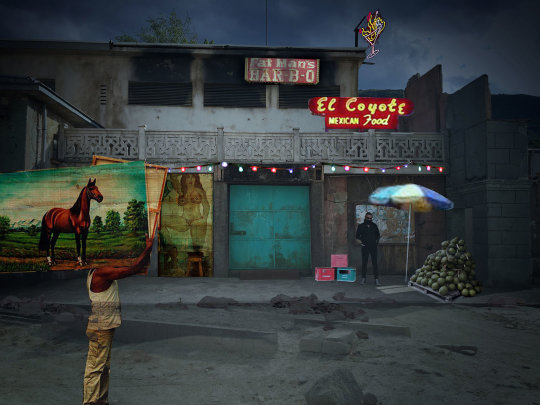
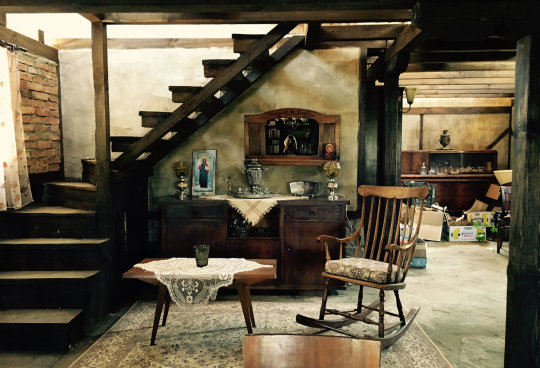
MM: Is there a production you are most proud of?
RM: I have been lucky to have worked with some of the worlds best Directors and Production Designers and am exceptionally proud of all the projects I have worked on. I think the most fun I’ve ever had recently was working on the film The Hitman’s Bodyguard. This was entirely down to the production designer and his team. I must have laughed every day on that film and it really didn't feel like work. The result was a genuinely funny movie which looked great and that we all enjoyed being part of. My most difficult project location was probably up on the Isle of Skye, where we shot Macbeth. We worked for days in harrowing conditions carrying rocks up a mountain to create a very simple stone plinth which was the base of a ceremonial burial fire in the scene. I was soaked and utterly broken, although the build looked great. On screen this was an extremely powerful moment but I think it lasted less than two seconds. There must be a lesson in there somewhere.

MM: Art directing a feature film is an enormous undertaking. Where do you begin on a project like Macbeth or The Imitation Game?
RM: The creative process of designing a film is one which generally begins with lots of research and reference material. Especially on a period production. There are so many things you can take from reference not just in terms of history but also the human details. For example, when we were dressing Alan Turing’s Hut in Bletchley Park, one dressing element was to chain a tea mug to the radiator beside his desk. This was a small but historically accurate detail which we had read about. At the time mugs were sparse, and a cup of tea was very important when trying to win a war with mathematics. It can be little things like this that collectively add to the richness of a film set. Macbeth was much less historically locked so we had more creative freedom to draw reference from things like stretched waxed animal skin tents from North America, primitive art, religious iconography, world war one imagery and contemporary photography.
MM: What do you want readers to know about you, as an artist and as a person?
RM: I’m actually a fairly private person and I don't use any form of social media platforms other than my website which exists primarily as a job portfolio rather than a performance window to the world. I like to keep my head down and my circle small. I believe if you work hard and are good at what you do, then most things are possible. There used to be so much noise in my life, and I wasted a lot of energy on the wrong things. Its a huge cliche but last year I had a little boy and I feel he has helped in a big way to clarify whats important in life.


MM: Do you have advice for students looking to pursue film production?
RM: I never considered a career within the Art Department of the Film and TV Industry when leaving school, because I honestly didn't know they existed. It’s a relatively closed industry. I went to Architecture school and followed that path before crossing over. Interestingly though the original Art Directors in Hollywood were Architects, so the key skills are essentially the same. I made a contact through a friend and was lucky to find a way in through her. I took a holiday from a steady architecture position to do a week of work experience on a kids TV show. From there, I left my job and worked my way up through all the positions in the Art Department; Assistant, Graphic Designer, Standby Art Director, Assistant Art Director, Art Director. Starting in TV and slowly moving into Film.
If I were to do it over again, I’d still go down the architecture route but perhaps just do just three years follow by a post grad specialising in production design. Once you graduate it is hard to get your first break because you rely on word of mouth and are permanently marketing yourself, putting feelers out for any new projects starting up just to get experience. So a lot of it is about timing and luck. There is a harsh, survival of the fittest element to the industry. You have to be able to adapt quickly to change and there is no space for tardiness, mistakes or an inability to do the job. And there is little time for a personal life. The project on hand is your life and the likes of Steven Spielberg or Barry Levinson demand this commitment, since they too are giving all they have to their art and it is their name stamped across the picture a year later.


2 notes
·
View notes
Text
The YouTubers Keeping Pets Entertained During the Pandemic
Since the pandemic started, I've been using YouTube far more than I used to. Workout routines, sewing tutorials, mindless feel-good clips of babies hugging animals: YouTube has all of these in abundance. But all of these pale in comparison to the type of video I put on most frequently. In our house, kitty TV reigns supreme.
YouTube is filled with content aimed at dogs, cats, and their owners. The varieties are endless. Birds alight at a feeder, a GoPro hidden nearby to record their comings and goings. An invisible hand drags a string toy back and forth. Fish in a koi pond bobble to the surface of a pond. A camera moves smoothly through a park, capturing trees and squirrels. These videos are long, often over four hours, and the most popular ones have millions of views. I put on at least one video per day, which amounts to, at minimum, 28 hours of pet TV per week. Most YouTubers would kill for those numbers.
It wasn't always like this. But one of our cats, Graymalkin, got much more attached and energetic when I started staying home all the time. He used to sleep during the day, while I was at grad school. Then, in the mornings and evenings, he'd sit on my lap and purr as I worked. In the spring, he lost his tiny mind. He spent all day zooming around the apartment, mrrrring and chirping for attention. He begged for treats. He planted himself on my keyboard. He constantly fought my partner for control of his gaming chair.
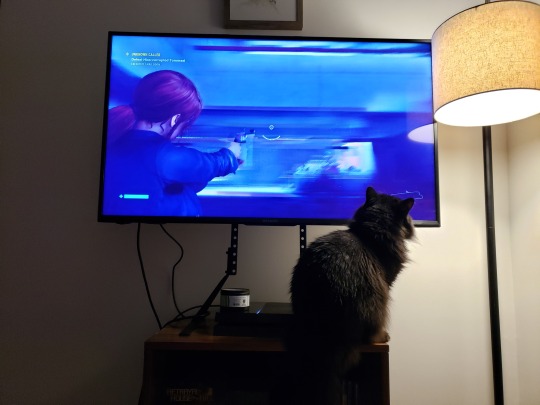
Greymalkin the Cat, watching someone attempting to play Control / photo by author
One afternoon in July, I searched "cat tv" on the advice of a friend. Maybe some videos of birds or squirrels would take Gray's mind off the gamer chair. And it worked, at least for a little bit: Graymalkin hopped up on the TV stand and parked himself as close to the TV as he could. In his glassy, green eyes were reflections of hummingbirds. When he was most engaged, he reached up to bat at the screen with his weird little cat-hands.
After about five minutes, he curled up in my lap, bored. But I wasn’t bored. After the video ended, I put on another. And another. There were so many videos for cats and dogs. I sat on the couch, watching Graymalkin watch TV.
For both of us, it was a portal into the strange, sometimes eerie world of The Algorithm. In one video, an enormous cockroach skittered across the screen, freaking us out. In another, an otherwise tranquil recording of a bird fountain, a Minion toy loomed ominously above the birds. Every few minutes, the footage would jump cut to a slightly different angle, making it look like the Minion teleported a few inches to the left or right. Eventually, I selected so many videos from Japanese creators that YouTube, confused, started serving me ads in Japanese. While I tried to follow the plotlines of commercials in a language I don't speak, Graymalkin swished his tail, impatient for images that triggered his hunting instinct.

A still frame from a video by TV BINI
No video captivated his attention for more than a few minutes, but for those minutes, he was rapt. Sometimes I caught him staring at the screen even if it was switched off, as if he was trying to suss out the TV’s inner workings.
Eventually I noticed the viewer counts on the cat videos: hundreds of thousands, sometimes even millions, of views. Many of the videos came from the same channels, and these top channels were monetizing their content by running ads. How much money, I wondered, were these creators making from pet TV? Had they stumbled upon success by accident, or had they worked hard to win the chaotic gamble of making money through YouTube? And were animals really watching these videos for hours at a time?
Identifying the inner workings of the pet TV biz became an obsession. I wanted to know more about the people who had figured out this YouTube niche, harnessing the power of SEO plus the fretting of helicopter pet parents for ad revenue. So I reached out to two YouTube creators: entrepreneur Amman Ahmed, the founder of Music for Pets (which includes the YouTube channels RelaxMyDog and RelaxMyCat), and Bini, who runs TV BINI.
RelaxMyDog and RelaxMyCat both post new videos almost every day. No two are the same, but many follow a similar formula. The first element is either still photos or slow footage of expansive natural landscapes, sometimes with wild animals in the background. The second element is slow, soothing piano or strings, the kind of music you’d hear at an upscale spa. The audio loops infinitely and the video plays on and on, sometimes for up to fifteen hours.
Ahmed really is a savvy businessman who saw an opportunity, then threw everything he had at dominating it. Though RelaxMyDog now has 587,000 subscribers and RelaxMyCat has 472,000, they started out much smaller. “I self-funded it, had no investors. I 100% owned the company. It's luckily, over the years, got bigger and bigger,” Ahmed said, video-chatting me from his temporary home in Kiev. Music for Pets is headquartered in Manchester, in the UK, but Ahmed travels frequently for work. He spent the beginning of 2020 in Brooklyn, but then saw the COVID-19 writing on the wall and left the country. Fortunately, Ahmed told me, many of Music For Pets’ fifteen employees – including filmmakers in Indonesia, South Africa, and Romania – work remotely. Music For Pets is a complex operation, with lots of cogs and levers. Luckily, Ahmed can make sure all those cogs are turning properly from anywhere in the world.
In 2012, Music for Pets was just Ahmed and his new business partner, a music producer from El Salvador named Ricardo Henriquez. Ahmed had wanted to start a business centered around relaxing music for people, and in searching a freelancing website for music producers, stumbled across Henriquez. Henriquez's dog suffered from anxiety, and so Henriquez and Ahmed wondered if calming music would work just as well on dogs as it did on people.

A still from from a Relax My Dog video
Eight years later, Music For Pets makes much more than just music. There's a subscription service, which allows users to play ad-free videos for $4.99 a month. They even have a mobile app, called Games for Cats, that lets cats bat at fish and bugs on a smartphone screen. “In 2019, l think twenty million cats and dogs around the world consumed content on RelaxMyDog and RelaxMyCat,” said Ahmed. Music For Pets’ viewership numbers have hit an all-time high in 2020, and Ahmed thinks that worldwide COVID-19 quarantines are at least partially responsible. Pet owners who have started working from home are disrupting their animals’ routines, potentially causing anxiety. “Cats are looking at their owners like, ‘Why are you still here?’” he said. Another possible explanation for Music For Pets’ popularity is that people find the videos soothing. “Our content is now becoming more designed for humans and pets to watch together,” Ahmed told me. Music For Pets ran a survey that asked viewers if, during quarantine, they were watching RelaxMyDog alongside their pets. 87% of respondents said yes.
It’s easy for me to see – and sense – the human appeal. Focusing on a sunlit beach and mellow music is exactly what my meditation app asks me to do. I seem to get more out of these videos than Graymalkin, who wanders away after he realizes he can’t actually commit any bird murders. And I am not the only one who feels this way, according to Ahmed. “We see a lot of comments where people are like, ‘Look, I don't have a dog. I enjoy watching this while I'm high,” he said. But motivations notwithstanding, enough viewers have clicked on RelaxMyDog and RelaxMyCat videos to generate a business that Ahmed says is valued at seven to eight million dollars.
Bini runs a very different kind of operation, one that doesn’t generate the same kind of profit. While Ahmed said he regularly talks to journalists, Bini – who declined to give her real name – rarely does. When I reached out to her to ask for a phone interview, she said she would prefer to talk over email. "I'm an extremely private person," she wrote. Her reclusiveness contrasts with the popularity of her channel, TV BINI, which has 105,000 subscribers. Some of her 156 videos are filmed, while others are animated, but she makes and edits them all. "TV BINI is a one-woman production," she wrote.
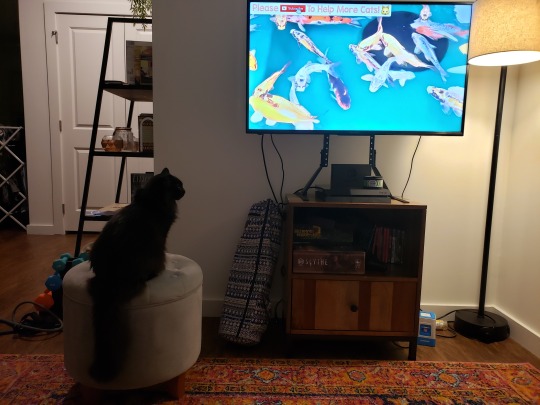
Graymalkin, the author's cat, considers the fish in a video for which he is ostensibly (but doubtfully) the target demographic. / photo by author
Bini, who lives in California, started TV BINI in 2014. However, she's only recently gotten a high enough subscriber count to feel like her efforts are paying off financially. "It wasn't money that kept me going, that's for sure," she told me. What’s kept her going is the thought that she’s helping both cats and cat owners. Many viewers have posted clips of their pets reacting to her content. “The cat reaction videos and positive comments by pet owners motivate me to continue making videos,” she said.
Bini told me that videos of prey, or objects that move like prey (such as string dragged across the screen), help cats exercise their basic predatory instincts. And though she creates content with cats in mind, other species react, too. Bini sent me a list of videos depicting other animals, like a peacock, a praying mantis, a dog, and a lizard, interacting with her videos.
But how should we interpret animals’ reactions to pet TV? According to Dr. Kersti Seksel, a veterinary behavioral expert who practices in Sydney, Australia, it’s hard to know. “There’s very little research on [pet TV],” she said. Some studies have indicated that certain genres of music may decrease stress responses in dogs, such as a 2012 study in the Journal of Veterinary Behavior that linked classical music with more sleeping and less shaking or barking in shelter dogs. In addition, Ahmed pointed me towards a 2017 study in the journal Physiology and Behavior which suggests that soft rock and reggae music relax kenneled dogs.
However, Seksel says that the way cats and dogs perceive video is starkly different than the way we perceive it. Both species have a far sharper sense of smell than we do, which means that they rely on olfaction – a sense that video doesn’t cater to at all. They also hear a far broader range of frequencies than humans: dogs can hear up to 45,000 Hz (hertz), while cats hear up to 64,000 Hz. (We only hear up to 23,000 Hz.) Furthermore, the placement of both cats’ and dogs’ eyes means that their field of vision is much wider than a human’s, allowing them to sense more peripheral motion. “[Cats and dogs] live in their world. They hear ultrasound and infrasound sounds that you and I can't even detect,” said Seksel. “Maybe the birds outside are making noises that we can't hear, but the animal can hear.”
As a result, Seksel told me, it’s hard for us to know if the basic concepts conveyed by videos come across the same way to our pets as they do to us. While a video with fluttering feathers and a high-pitched song may convince us that it’s depicting a bird, cats and dogs may only perceive some of the signals they associate with birds. That’s what might have happened with my cat, Graymalkin. A video could suggest the presence of a bird, so he checks it out. But when he inspects the TV, he doesn’t smell a bird, or hear the ultrasonic frequencies a real bird would make. In the end, he might be wandering away because he’s bored.
Seksel said that pet TV likely caters more to our understanding of entertainment than to a cat or dog’s. “I think our expectations of what the animals will do are wrong,” she explained. “It’s based on, ‘Well, I can sit and watch a TV show, I can watch a movie.’ But even with humans, if the movie doesn't have something that changes every five to seven minutes, you lose interest. Same with video games.”
Ultimately, the audience that pet TV caters to isn’t pets. It’s us, the pet owners. As in the children’s publishing industry, the supposed target audience isn’t the one making choices. Little kids don’t have the purchasing power to buy books, so publishers market to their parents. Similarly, cats and dogs don’t have the opposable thumbs necessary to put on games or videos. Their owners are the ones who scroll through YouTube results and pick the option that seems best. In this context, the “best” video might appeal to a cat or dog, but it might also be “the video that appeals most to people.”
However, Seksel said that just because there isn’t research to support pet TV, that doesn’t mean it’s completely ineffective. “We need to think about animals as individuals,” she said. “Just because my dog doesn’t react to TV doesn’t mean that someone else’s dog wouldn’t react to it.” Seksel stressed that dogs and cats, like humans, respond to stimuli based on their preferences. Those preferences don’t have to conform to logic, or to scientific consensus. “You might like playing golf, I might not like playing golf. That doesn’t mean golf is good or bad,” Seksel added.
In a follow-up email, Ahmed agreed with Seksel’s analysis. Because there isn’t much research on how cats and dogs react to TV, “we took the approach to pump out loads of experimental content because we have a huge audience,” he said. That way, Music For Pets could engage with as many animals’ preferences as possible.
Bini hopes the popularity of pet TV will spark more research into animals’ responses. “It would be exciting to learn the differences between human and animal motivations and perceptions,” she said. Ultimately, she believes that any entertainment that makes sedentary indoor animals move around is a good thing.
Speaking with Seksel made me realize that, for me, pet TV is a small way of asserting control. It makes me feel like I’m taking steps to improve the life of a living creature. Existing in a pandemic, especially a pandemic that so many people in my country seem hellbent on minimizing, makes control over anything seem like a pipe dream. I’ve lost the power to make life much better for myself, or for people that I care about. But my cat? I can fill his days with endless clips of birds. Maybe that means something to him. Even if it doesn’t, it is still soothing for my world to contract, to become as compact and frictionless as a cat watching a TV screen, birds of prey reflected in his lambent eyes.
The YouTubers Keeping Pets Entertained During the Pandemic syndicated from https://triviaqaweb.wordpress.com/feed/
0 notes
Photo

ILM Shares ‘Star Wars Stories’ at Gnomon
ILM’S Paul Giacoppo, Charmaine Chan, and Jay Machado discuss their career paths, making Rogue One, and much more.
From the opening shot until those final moments before the Tantive IV takes off into hyperspace, Rogue One’s visual storytelling takes center-stage in a big way. The credits run long for a reason, and that’s because hundreds of people at Industrial Light & Magic worked tirelessly to bring every major visual to life in a way that felt both “classic” and new at the same time. Last month at Gnomon University in Los Angeles, three of those visionaries brought their work to an audience of eager visual effects students in a special presentation called Star Wars Stories: An Evening with ILM. ILM’s Paul Giacoppo, Charmaine Chan, and Jay Machado brought decades’ worth of experience to their discussion.
Machado was on the modeling team for The Force Awakens’ Millennium Falcon, and created the award-winning Imperial Star Destroyer that we see rise from the shadows in Rogue One. Charmaine Chan spoke of her history at ILM, illustrating how careers grow and change on the company’s campus. Giacoppo is behind some extremely recognizable work that reaches back decades over the history of Lucasfilm and ILM; the crowd was hooked when he showed off his visually memorable “Hulk Smash” shot from Marvel’s Avengers.

But while their extensive careers could take up an entire editorial on their own, the focus of the evening was visual storytelling, and how ILM created Rogue One. Giacoppo outlined the overall objective of what the team wanted fans to see and understand: “The idea behind our work on Rogue One was that it had to have the visual feel of the classic 1977 Star Wars, but have a new vision as well.”
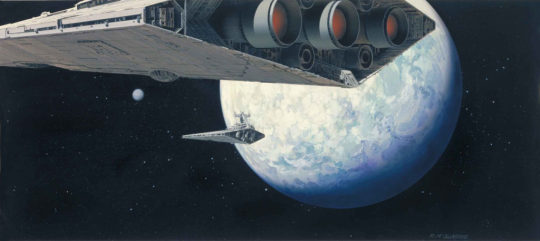
When it came to seeking out inspiration, the team had to look further than the usual standards. They began with concepts by Ralph McQuarrie, Joe Johnson, and several others that defined the look of Star Wars. These angular, expansive, and recognizable styles still reflect throughout Rogue One, but the team looked at what they could do differently as well, because the story in itself was different from the norm. “[McQuarrie and Johnson’s concepts] were part of what the visual language of Rogue One was,” said Giacoppo. “But it was a different kind of movie. It was a true war movie, about people with a mission to complete. So it’s not exactly a ‘hero’s journey,’ and we had to change what we were doing in order to tell this different kind of story.”
Giacoppo dove into set design, then, showing off digital recreations of classic sets that were created by John Knoll, ILM’s chief creative officer and a staple of Star Wars creativity. Knoll, attempting to explain how characters would move through various scenes, created digital set tours practically overnight in order to explain his vision.
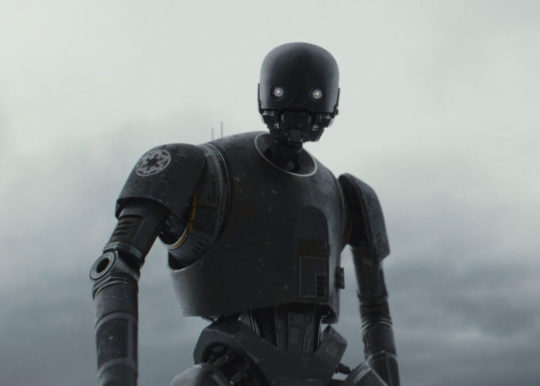
Giacoppo then dove into characters that were created digitally for the film, focusing first and foremost on K-2SO, who he says has been part of the Rogue One story since its original pitch. K-2SO varied greatly from past on-screen droid companions, who were so often cute, or at least a little more friendly-looking. “He’s intimidating, he’s really stealthy, and he’s huge… and he was always an Imperial enforcer droid.
“There was a lot of time spent with the texture artists to get those same materials and weathering we’re used to in Star Wars,” Giacoppo explained, noting the details that showed Kaytoo’s age and length of use.
The team took designing Kaytoo very seriously, spending hours on specific details about how he would emote. The team looked at more eyes than one can count on two hands, then went through tests of how they would move — if at all — and how Kaytoo looked when expressing himself. “There was a big push to have a part of him blink, and to have a part of him move his mouth,” said Giacoppo, noting that such a thing is a rarity among Star Wars droids, who often reflect a much more industrial feel in design than most AI-driven beings within the genre. “But it just didn’t feel like Star Wars. See, he’s all blinking and jittering around… there’s too much going on.” With animation supervisor Hal Hickel’s guidance, the team ultimately went with “this sort of more impassive mask”, said Giacoppo, allowing fans to read and “project” emotions onto Kaytoo as they got to know him.
As a special bonus, Giacoppo showed a tiny clip of K-2SO playing with toys that paired with some very familiar audio from Alan Tudyk’s Wash in Firefly (“Curse your sudden but inevitable betrayal!).

ILM’s Jay Machado, a hard-surface modeler and texture artist, was a welcome and familiar face that evening. As a Gnomon alum himself, Machado’s post-grad years have been more than exciting. For Rogue One, following his Millenium Falcon re-creation, Machado was tasked with creating iconic ship-looks once again. To set the tone for the talk, Machado showed off that iconic opening shot from A New Hope, where the belly of the Star Destroyer sails over the camera in pursuit of Princess Leia’s Tantive IV. “We wanted it to feel like the exact same era,” said Machado. So, his team at ILM went to the root of all builds to recreate and design ships in Rogue One. “For the ships, we went up to the archives, we took lots of photos, we scanned things, stuff like that — all to get the ships to be just right,” Machado told the crowd. “There’s a few people still working at ILM that we were able to talk to, like [long-time ILM VFX artist and supervisor] Dennis Muren, who [shot] much of this originally, and that really helped when it came to making it accurate.
“What I was surprised by is that the original Star Destroyer is only three feet long…a lot of the panel lines are drawn in with pencil. And we wanted to match that so that in a way, you could watch Rogue One and seamlessly start A New Hope.”
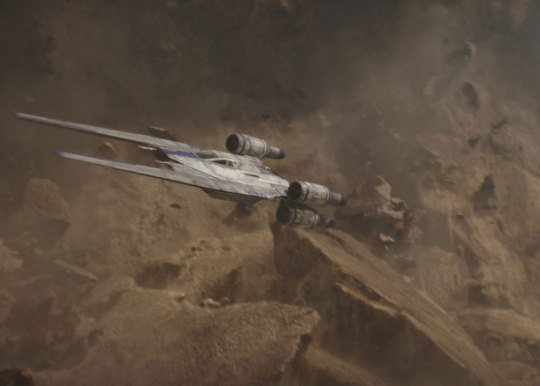
As far as new ships went, Machado noted that the tasks were just as difficult, but worth every grueling second. “Working with Doug Chiang and the art department, we had to design [the new ships] in a way that felt familiar so that they would blend in seamlessly with the ships we know and love.” Machado highlighted the U-wing, Krennic’s ship, and the new TIE strikers, stating that they were kind of meant to “compliment” the U-wing, with forward-sweeping panels and a unique, planet-specific use.
What may have been most exciting was the creation of new ships to the canon, like the Ghost from Star Wars Rebels, which featured on screen twice in Rogue One. “It fell to me to actually [build the Ghost] and it was kind of a secret project,” said Machado. “Well, at first it was a secret. Nobody else was supposed to know about it. I was supposed to do this quickly, and I had to design it in between my daily work so that people within the office wouldn’t start getting suspicious,” he joked. There are panels and pieces that might look familiar, too — parts of the Ghost might look similar to the Falcon, and that’s no mistake.
One other major ship from Rebels that ended up in Rogue One came all the way from the Knights of the Old Republic games, originally. Hammerhead cruisers, which Princess Leia worked with Kanan Jarrus and Ezra Bridger to steal for the Rebellion in Star Wars Rebels, played an integral part in Rogue One, and Machado was among those responsible for their finished designs on the big screen.
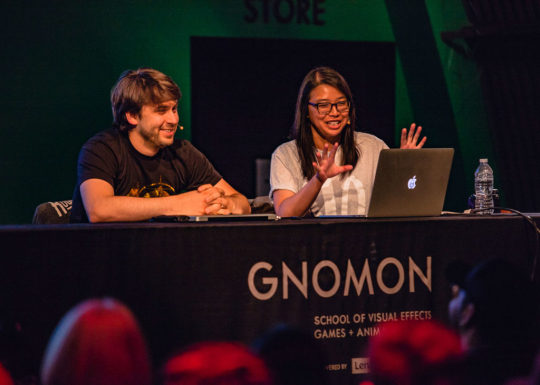
Charmaine Chan’s presentation focused more on the process of growing her career before and after ILM. As an up-and-coming artist who veered off the trail that her parents originally wanted (worry not — they were ultimately supportive either way), Chan hit the ground running by creating work early and producing it every day. Since joining ILM, Chan has worked on more movies than one can count — a once-over of her IMDB page shows credits for Transformers, Captain America: Civil War, Jurassic World, and more. But her beginnings were in Web development.
According to Chan, she learned HTML, CSS+, and more “so that I could build Spice Girls websites” as a little girl. As that hobby grew, Chan broke into graphic design, then Flash animation. (As someone who started her career building Star Wars and N*SYNC fansites, this writer can relate.) “That’s what really started all of this, because I started watching movies closer and learning what it took to compose a full shot. There’s lightning, texture, and all sorts of details to consider, which I found really interesting…it really helped me move into this form of art.” Chan took those skills to the next level, learning visual effects, making motion graphics (“You know, like, DVD menus!” she joked) and eventually applying for a digital research position at ILM. “That gave me a really great overview of what the VFX process is,” said Chan. “I got to touch the shots at the beginning and the end.” From there, she kept working her way into a position at ILM that has grown and spanned over a decade, leading to her work as a compositor today.

The night was a wonderfully informative look at how the story of Rogue One was brought to to the big screen with stunning, modern, yet familiar visuals. One of the biggest surprises for this writer was learning about the sheer scale of people working on each Star Wars film. Hundreds of names scroll down through the credits after every film, but there’s just something unique and different about putting faces to those names and realizing just how many people it takes to make our favorite galaxy far, far away come to life.
14 notes
·
View notes
Photo

Neuroethology of Toads
All right, I've been feasting on low-hanging b-movie fruit for too long – let's try a short. This particular short was not intended for public consumption. It's meant to be informative, but not what you'd call entertaining... despite which, it's often very entertaining. It's also divided into discreet sections, meaning the Brains could have picked and chosen their material to make it fit in whatever time they had left over from the movie. I can't really compare it to anything that ever aired on MST3K, but I was riffing it in my head the entire time I watched it and I highly recommend heading on over to YouTube and taking a look for yourself. If I’ll never unsee this shit, I’m gonna drag you guys to hell with me!
'Neuroethology' is the study of what goes on in an animal's brain – but unfortunately for all of us who want to know what the hell our cats are thinking, it's got nothing to do with reading the animal's mind as Markov the Magnificent does with Alex the Chimp. Rather, it's an attempt to understand the relationship between stimulus and behaviour. In Neuroethology of Toads, the behaviour in question is snapping at prey, and the scientists want to know exactly how the toad comes to the decision that something is edible, hoping to learn how to program better object recognition software for robots. They devise a series of experiments that first establish what stimulus is necessary, and then probe deep into the inner workings of the toad's brain.
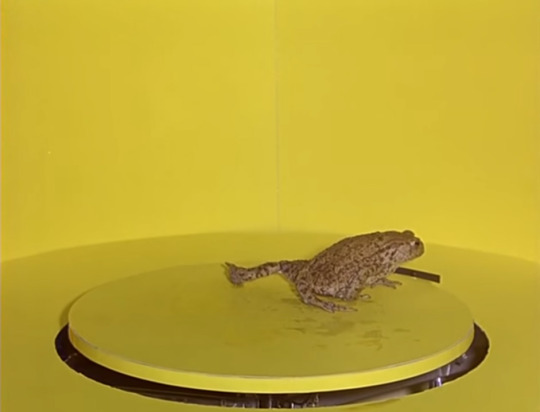
This sounds so simple and dry when I just describe it. In practice, it is bizarre. The first experiment sees the toad placed on a platform while a machine moves a piece of black cardboard in a circle around it. This experimental setup is called an 'arena', which makes one think of some kind of toad gladiatorial combat. If the cardboard is moved horizontally, the toad tries to eat it. If it is moved vertically, the toad ignores it. The scientists decide to refer to this as 'worm' and 'anti-worm' motion. They investigate further, placing the toad in a box to watch lines move worm-wise and anti-worm-wise across a screen. The toad strikes repeatedly. Food is always out of reach, yet it cannot help itself. Its brain is not complex enough to catch on to the trick, leaving the hapless amphibian a slave to its reflexes.

It's difficult to watch this and not come up with riffs. I imagine Crow narrating the toad's frustrated internal monologue while Tom Servo makes observations like, “you mean all this time, all worms had to do was learn to stand on their heads?” In the break between the short and the movie, the bots attempt to ply Mike with hot dogs moved in weenie and anti-weenie motion across the hexfield. Does mustard trigger his feeding reflex? Does sauerkraut? Pearl watches, trying to steal their results. Bobo interrupts, trying to steal the hot dogs. He thinks they’re bananas. Everything looks like a banana to Bobo.
Having established a stimulus, the narrator goes on to talk about toad brains, and how the scientists implanted electrodes in them to keep an eye on the electrical activity within. One of these enhanced cyber-toads is strapped to a platform to watch lines performing worm motion, and its toady little thoughts appear on an oscilloscope. The machinery involved really looks like it ought to be disintegrating toads with sound waves or something. Watching it rotate silently into position while the paralyzed toad sits there with a wire in its head is deeply ominous. The lack of background music somehow makes it worse.

Here we learn that while toads have some neurons that specifically recognize worms, there are others that specifically recognize things that are not worms. The worm cells and the not-worm cells have to agree that something is definitely a worm before the toad will bite it. The narrator continues to say stuff like “the same stripe in anti-worm configuration goes practically unresponded.” There are diagrams with the text in German, which don’t make things any less sinister or amusing.
The most horrible moment of all, however, is when the narrator starts talking about how the image of a large moving square activates neurons involved in running away. We don't get to see this particular experiment, but we can imagine it in detail: the toad, squashed on a table with wires in its brain as this giant shadowy shape looms over it, wanting to flee but unable to move, while lab-coated humans peer into its mind with machines. Holy shit. Maybe that's what those abducting aliens are doing! Maybe somewhere out there in the space internet is a video called Neuroethology of Humans, discussing how our brains recognize things that are and are not ice cream!
Then we learn about how the scientists rendered the toad brains radioactive before dissecting them.
I'm not even kidding. They offer a reason for it, but the viewer is forced to confront the fact that these German scientists created radioactive toad brains. What kind of science is that? I'll tell you – it's mad science, that's what it is! Anybody whose work includes torture, brains, and radioactivity is either a supervillain or... there's no second option there. That's a supervillain. It probably all ties in to their plan to kill Captain America.

Finally, the scientists must test their hypothesis about toad decision-making. To this end they sever some of the neural connections, figuring if they've got this right, then the stimulus that previously made the toad want to run will now make it respond as if to a worm. And you know what? They're right! This poor toad is confronted with something that ought to terrify it, and instead it tries to bite it. Imagine this toad escaping into the wild. A shape appears beside it. It strikes, expecting food, only to be plucked from the ground by a pelican. It dies never understanding, believing to the last that it ought to be eating a tasty worm right now.
The film isn't meant to do anything but present the results of a scientific investigation. The narrator's tone is detached throughout, and there's never any music or any attempt at humour. There isn't even a title screen. Only the brief opening sequence shows a toad outside a laboratory setting. The whole thing is as un-cinematic as possible, yet it is often more engaging than some movies I've seen. I certainly felt more involved in this than I did in The Starfighters. Why the hell is that?
I think the answer lies in a property not of the toad brain, but of the human one: we want to find patterns. When presented with a set of information, we will attempt to see a pattern in it, and if we can't we will sometimes imagine one, as we do when we see shapes in the clouds or faces on Mars. What seems to be going on in Neuroethology of Toads is a sort of narrative pareidolia. We're being shown a film, so the 'pattern' to look for ought be a story. There isn't one, so we make one up.
If Neuroethology of Toads had a story, it ought to be a story about the scientists learning how toad brains work. The problem with this is that we never actually see them. There are a few shots of young people, whom I imagine are grad students, working with the equipment, but these are very brief and do not focus on the individuals' faces, so we get no real impression of them. What we do see is the toad reacting to a series of situations – so by default, the toad becomes our protagonist. It is the toad we sympathize with, and it is the toad's internal monologue that we are tempted, as I noted above, to imagine.
This means the 'story' is a horror story. We first see the toad in a fairly normal toad environment, eating real food. Then it is trapped, teased, tortured, and finally murdered so that its radioactive brain can be dissected. Just to rub it in, we're told that these toads are hand-fed. They trusted those experimenters, and they were fucking betrayed. The fact that the experiments going on are the kind of stuff animal rights people have aneurysms over just reinforces the idea that the toad is a doomed victim, and then, of course, there are the repeated subtle reminders that the toad has no idea what is going on. At least Mike, Joel, and Jonah know they're at the mercy of a mad scientist! The toads can't even understand that!

Worse, it's possible to imagine the same things happening to you. We humans like to think that we're more than the sum of our parts, that our minds are somehow above and beyond our bodies, but that's just not true. Google 'brain injuries' and you'll find stories about people who suddenly began believing that their loved ones had been replaced by impostors, or who lost the ability to read. Even if you believe in the soul, the brain is the computer we use to interpret our world, and when something goes wrong with it the results are truly fucked-up.
The cherry on this horror sundae is only added retrospectively. If you watch the short a second time, you will have to revisit the first five minutes, which are the relatively harmless experiment in which the toad is following a piece of cardboard around in a circle. This part is really quite funny, especially when the term 'anti-worm motion' is introduced. Then you descend into madness, as the experiments get more and more horrible and you realize that the first bit wasn't so innocuous as you thought. It's only the first step on a slippery slope that eventually drops you straight into toad hell.
14 notes
·
View notes
Text
Andrea Schmitz
Motion Graphics Designer/Animator
www.andreaschmitzzz.com
New York City
Age 27
She/Her
How did you get your start in motion design, animation, or whatever it is that you do?
I originally wanted to be a writer, and I faithfully wrote buckets of fanfiction and short stories up until the end of high school. I had actually planned on going to college for creative writing, but I was afraid of job prospects for fiction writing, and ended up going to Northwestern for film instead. Once I was there, it was clear to me that I hated film. For the first two years I felt like I was wasting time and money because I wasn’t learning anything that felt practical or interesting to me. It was also freezing in Chicago, and I quickly discovered that I hated filming on set (and I hated that most of the other film students only wanted to talk about film). Then, in 2012, I took the only animation class on campus, which taught puppeted character animation in AfterEffects. I was good at it, and it was fun, and so I decided to do that for the rest of my time there, along with sound design (because you could do both from a warm, snug bed).
I was one of three students interested in animation in my year, and one of three women killing it in sound design. I spent my time at school working project to project, designing opening credits for other film students’ web series, making a short animations for class, and sound designing other people’s short films. I tried to learn something new with each project, and eventually I worked with the animation teacher on an explainer series as an independent study in my third year. I also had two unpaid internships – one in Santa Monica making background screens for a 3D kids show, and one in my hometown of Little Rock where I did not do much actual work, but my supervisor gave me access to his Animation Mentor account so I could take some lessons.
In my last year at Northwestern I was terrified that I was nowhere near ready for a job in motion graphics or animation, and I didn’t want to do another four years of school. Over my senior year winter break, I showed a former Disney/Nickelodeon animator who had recently moved to my hometown one of my old sketchbooks that I had on hand at the time, and he told me that I was four years behind everyone graduating from an art school that year. I went back to my car and cried. I had been trying so hard to make something from the limited resources for animation at my school, and I still had so far to go. I made a plan to do everything I could to make up that time as quickly as possible.
This feedback triggered 3 years of panic-fueled creativity that I still have mixed feelings about because, although it kickstarted a creative growth spurt, it came from a place of fear, which affected the quality of the work. I took five classes that fall, blindly guessing pre-production for an animated short that I did not end up making in an independent study. Northwestern did not provide a 3D class, so I took the train once a week an hour south to take night classes in Maya at Columbia College on top of my regular workload (not for credit, because taking this six classes wouldn’t have been allowed by the school). Near the end of the year, I frantically applied to any and all jobs listed online, figuring that I would crash-course learn whatever I needed to and move wherever I had to to work. By the time school was ending, I had no job offers, but I had found a grad program that put equal emphasis on writing and art that felt just so me.
Two months before I graduated Northwestern, I applied and got into the MFA Visual Narrative program at the School of Visual Arts in NYC. I left NU three weeks later to start the program, and flew back every weekend to wrap up classes, graduate, and move out. The MFAVN program functions as an on-campus high-volume program for June and July every summer for 3 summers, but is an online course during the 2 years in between, so you can attend grad school and hold down a job in another state at the same time.
After leaving the first summer, I moved to Austin, and shortly after got a job making graphics for standardized tests. I couldn’t keep any work from this job for my portfolio since all of it was confidential, so sometimes it felt like I was making art all day and throwing it into a hole, but I learned vector illustration from that job. The next year, I moved to NYC for thesis year in order to be closer to the school and its resources, and worked 9am-2am every day for 6 months on a 10-minute frame by frame animation. By the time I left the MFAVN program I had three 5-10 minute animated shorts under my belt ( x, y, z ), but remained anxious about their quality because I had rushed all of them. I would try to fit huge concept projects into a tiny timeframe and overextended myself to reach my own goals. It took me a long time to physically and mentally recover after thesis, and the scale of the production did not achieve equal scale success. I learned a lot, but it took me a year to want to draw anything again.
It took me four months to find a job after graduating. I applied constantly – hours and hours each day searching and applying to anything that remotely sounded like what I did. I made short motion experiments in the meantime, and took CE classes at SVA. I ended up getting my first job – a paid internship – through networking on the Motion Design Slack. It was an internship with a pharmaceutical marketing company. I worked there for 6 months until it became clear they would not hire me full-time and I was very overextended. I got my next job, again, by talking to other motion designers, at New York Magazine as a motion designer. I had the opposite problem there, where I was free to do what I wanted when it came to explainer design, but I rarely had fully animated projects to work on, and had a lot of downtime. I made a lot of side projects during that time. A few months ago, after a year and a half at NYM, I got my latest job at Insider, where I do more character work than at any previous job and have similarly free reign over my explainer designs.
It’s only in the past two years that I’ve felt safe and secure enough to let the panic-fueled mania subside and start to focus on what I really want out of my career. I’ve started writing again, and exploring ways to introduce story back into my work. Although the ‘advice’ that I was four years behind lit a fire under my ass to work as hard as I possibly could to become a professional in the shortest amount of time, my work definitely suffered for it, and I think a positive reinforcement would have left me with a better mindset. Maybe then it would not have taken me so long to start thinking about what I really want out of my career.
State your privilege – What circumstances may have helped or hindered you along the way?
I come from a privileged background. I am very lucky to have two extremely supportive parents, and they encouraged me to go to whatever school I wanted and pursue whatever career I wanted as long as I could make it work. They paid for both schools, and I had no loans. After I graduated, I lived off of leftover college savings money until I made my own income. Financial security and unwavering trust, love, and encouragement from my family gave me the time and safety to discover what I wanted to do and the means with which to learn it.
What are some best practices you use today?
I diversify the projects I invest my time in. If I animate all day at work, I’ll read or write or draw on the train, and bake or write at home. I’ll always have several projects going on at once, but I delegate them to specific times and places that work around my schedule. This way when I work on them it doesn’t necessarily feel like work, because rather than a constant slog, each task feels fresher and easier to jump into.
How do you define success? What would success look like for you?
My primary goal in life is to write and publish a book, and then to sit on the floor of a Barnes and Noble and read the book without buying it. It would make 12-year-old me proud, and that’s the only standard I hold myself to.
Success in motion graphics to me is making a living and having enough time to comfortably make my personal projects on the side. Creating and animating stories is fun for me, but motion design is the job. I really want get into developing more narrative fiction animated work, but that’s going to be a long journey to make that a job.
How do you balance your work with your personal life? How do the two influence each other?
My boyfriend used to work odd hours, and now he goes to school in the evenings, and that’s greatly influenced my schedule. I try to get work done while he’s out of the house, and that way I can try to put my work down whenever he gets home so we can spend some time together.
How have you learned to practice self-care? What do you do to take care of yourself?
I’ve been trying to go on more walks to break up the work day at my fulltime job. I try to stretch my neck, hips, back, and and knees as often as I can (IT’S NEVER TOO EARLY TO START STRETCHING). I got an ergonomic mouse that changed my life. I try to take long breaks between the freelance projects I take on on the side. When I have a project assignment, I often feel like I have to get it done IMMEDIATELY, and will push myself into working long hours at nights and weekends to achieve that. If this is the way I’m going to keep working, the compromise is that I’m teaching myself that it’s ok to say no, and to not respond to the person looking for animation help that I am perfect for if I am not 100% up to it. I didn’t draw for about a year after I made my thesis film – I know now I need time to recharge.
What advice do you have for those just starting out?
Talk to people! I’ve learned so much from the women of the Motion Design Slack and the people of Punanimation! Make friends, let them know when you’re looking for a job! (Don’t make friends TO let them know you’re looking for a job, just make friends and hang out.)
Make your projects! Don’t wait for validation! I wanted to make a short film post-grad but had no reason to make a short film, so I made Things Took a Turn so I’d have a reason to make a short film, and it held me accountable because then other people also had to make short films and I was in charge. Don’t do that exactly because that was an insane idea, but just know that you have the power to create opportunities for yourself!
Don’t panic! Make side projects because you want to, not because you feel like you’re competing against the world. Scale and volume can help you grow, but time and thought can help you stand out.
Find where nobody is doing the work and do the work! Aim to be different! If you think your work does not look like the work of someone else’s whom you admire, that’s okay. Lean into your differences!
Explore other fields, you never know how different media could work together!
Avoid hero worship! Just because people make good art does not mean they would make a good mentor. Find your own standards and hold yourself to them.
#animation#motion design#motion graphics#panimation#aftereffects#motion#2D#3D#illustrator#motion designer#motion graphics artist#video journalist#career advice#creative director#art director#crunch#burnout#freelance#visual designer#designer#directory
0 notes
Text
Q&A Intro to VR
A while ago, an old friend introduced me to some students doing a science project who asked me some questions about VR. They were kind of introductory questions, but I’m sure lots of people out there don’t know much about VR yet; so I decided to post my response.
“
Intro
Hey there future VR developers and creators!
My name is Alvin, and I've been working with VR and AR technology for about 5 years now. I recently graduated Fall of 2017 from UCLA with B.S. in Computer Science and a minor in Cognitive Science.
Just after graduating high school (wayyyy back in 2013), I remember getting the first Oculus Rift DK1 in the mail and setting it up. Even though it was a prototype, it was absolutely mind-blowing. I remember putting it on and being INSIDE Minecraft.
After that, I made it one of my goals to keep up-to-date with the industry and so while in college, I made a bunch of random VR and AR projects for hackathons. These include:
AR search - https://devpost.com/software/findar
VR walking - https://devpost.com/software/m-o-l-m
VR dodgeball - https://devpost.com/software/dodgelodge
These projects allowed me to learn a lot about how to make things for VR, and eventually landed me a research position at UCLA, under two psychology professors who studied human memory and human perception.
They wanted to study the human brain with the help of VR. So I built experiments using VR as a tool to put people into virtual worlds so that we can see how the brain reacts in certain conditions.
After two years of this, I was pretty set to go to graduate school, but those plans changed very quickly. A couple of my friends and I were getting odd jobs to develop VR projects for other people, and we were getting paid too!
So, instead of going to grad school, I and my team of friends started a company, called Escality (clever combination of ‘Escape Reality’), and now we make our own VR/AR games and also other applications for clients!
Here's the trailer for our first VR game on Steam!
Youtube: https://www.youtube.com/watch?v=PhzONE7-NQ0
Steam: https://store.steampowered.com/app/805320/Conjurors_Eye/
Okay enough about me, let's talk about VR!
Answers to Questions
How does VR work?
If you haven’t tried VR yet, you have to do that first. Find any way you can. It will blow your mind. And it'll be a good first step to understanding how it all works.
This video comes close to capturing what VR is like: https://www.youtube.com/watch?v=jNjmmLLBGHs, but seriously you need to try it for yourself.
Alright, after that, let's dive in:
A lot of things come together to make VR work, but the main two are:
Displays and Tracking
For displays, VR headsets are just screens (like your phone screen or your computer screen) with a bunch of fancy sensors.
But for these screens to make it feel like you're somewhere else, they have to show two images (one for each eye) that are slightly different. This is what's called a stereoscopic display (stereoscopic, meaning two views).
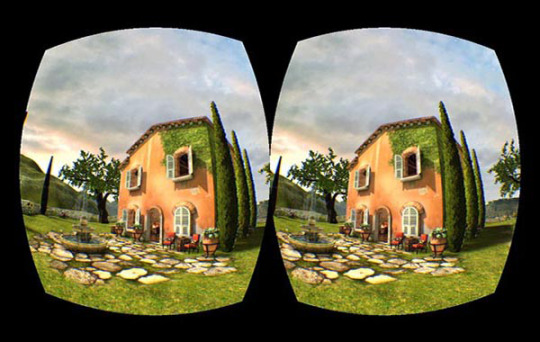
For tracking, well, it depends on the headset. But there's two main types of VR tracking technology: lighthouse (or outside-in tracking) and inside-out tracking.
Here's a good illustration of the difference:
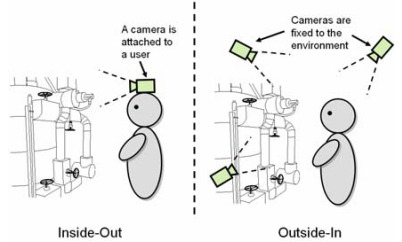
With inside-out tracking, the headset on the player has cameras and fancy sensors (like accelerometers, the kind of sensors used in phones to tell if they're upside down or not). The cameras and sensors work to understand the world around the player and make really good guesses to how the person is oriented.
With outside-in tracking, separate tracking cameras are placed around the room and look for certain markers on the player and/or headset to make a good guess as to where the person is and how they are oriented.
If you want to read more about this, here's a good article: https://www.wareable.com/vr/inside-out-vs-outside-in-vr-tracking-343
When you combine high quality stereoscopic displays with good and fast tracking, you can put that on someone's face, and they'll feel like they're somewhere else! That's VR!
How much money does it take to manufacture a VR headset?
The answer to this question is like the last one. It depends.
For example, let's take the Oculus Rift. It is currently being sold at $400, (released for $600). According to this article, it costs $206 for the parts, not including the labor put into putting it all together.
But if you look at other headsets, like the Pimax, it's being sold at $1000. There's no source for how much that one costs to make (probably a lot more).
How could you transfer VR files to space?
VR files are just regular computer files. If you've ever played a game on your computer, VR is the same thing! A VR game is just another computer game!
The main difference between VR and regular games is in the display (two images instead of one big one) and the tracking (using sensors and cameras to figure out where you're looking / how you're tilting your head).
How are VR movies made?
There are two types of VR environments: VR capture (taking the real world and putting it in VR) and completely virtual environments (building worlds from scratch in VR)VR capture techniques vary widely and usually involves taking a bunch of pictures of the world and mixing/matching them to form a sphere. Then based on where you're looking, you'll see a part of that sphere.
Here's a good article about how VR capture is done: https://www.viar360.com/blog/types-of-virtual-reality-capture-methods-that-allow-you-to-replicate-the-real-world/
For completely virtual environments, these are usually built in a game engine editor like Unity or Unreal Engine. 3D modeling is done to create virtual assets, then animation and VFX tools are used to make them move and look as if they're alive.
Popular 3D modelling software programs include: Blender, Maya, 3DS Max, and many more.
What supplies are needed to film a VR movie?
Assuming you're doing VR capture (taking the real world and putting it in VR), usually you'll need some kind of 360 degree camera. You can refer to the previous answer's link to that one article. Searching up each method for VR capture will give you an idea of what is needed for each technique.
Otherwise, if you're building completely virtual environments, all you need is a computer with a game engine downloaded (Unity and Unreal are the most popular and easiest to learn).
How much does the equipment cost to make a VR movie?
That highly depends on the technique used.
For simple 360 videos, all you would need is a 360 degree camera which costs anywhere between $100 to a couple thousand dollars depending on the quality of video that you want.
For more advanced techniques like photogrammetry and light-field capture, setups can run up to many thousands of dollars.
If you want to create completely virtual worlds, though, that's usually completely free! With software like Unity and Unreal, as well as Blender, you can create entire virtual worlds at zero cost. But it's a lot of work.
How are VR files stored or sent?
Again, VR files are just regular computer files. You can download a game from the internet, the same way you can download a VR game from the internet.
Will the VR video be clear even though they are heavily compressed?
Video files can be encoded at whatever quality you want them to be. They can be 1080p, or they can be 100000000 x 1000000000 resolution. That's up to you.
Whether or not your computer can run something that's 100000000 x 1000000000 is a separate issue (most regular computers today will have trouble even playing things at 4K).
Also VR headsets don't go that high.The HTC Vive Pro has a screen resolution of 2880 x 1600 (1400 x 1600 per eye).
The Oculus Rift has a screen resolution of 2160 x 1200.
The Pimax has a screen resolution of 2 * (3840 x 2160).
When you put a VR headset on, resolution isn't as important as refresh rate (the speed the screen updates per second). Research suggests that 90 Hz screens are optimal for VR use.
That means the screen has to update 90 times every second in order to feel good. Tracking also matters a lot, because with bad tracking, people can get nauseous and motion sick.
As for the video being clear, just make sure the resolution of the video matches the one that your headset supports. If you're using a HTC Vive Pro, make sure it's 2880 x 1600 (1400 x 1600 per eye), etc.
How do you incorporate sound into VR?
Most modern VR headsets have speakers for both the left and right ear. Spatial audio files exist that have data on how loud something is in your left ear vs. your right ear depending on where you're facing.
These types of files are called ambisonic audio files. Youtube supports First Order Ambisonics, and you can also read about this file type here: https://en.wikipedia.org/wiki/Ambisonic_data_exchange_formats#File_formats_and_metadata
VR games do this by default through the game engine code. So, when you play a game in VR made in Unity or Unreal for example, the sound will automatically be built-in and spatial, so that something on your left in VR will actually sound like it's on your left, etc.
Alright! That's all of the questions answered! Good luck on your project! Don't be afraid to ask some more!
”
0 notes
Text
Unmasking the Armorer: Emily Swallow Talks About The Mandalorian, Fans, and Set Life
Emily Swallow has appeared on both stage and screen, lending her talents to roles on The Mentalist, SEAL Team, Castlevania, and most notably as “Amara” on Supernatural and as “The Armorer” on The Mandalorian.
Maggie Lovitt (ML): When I told a couple of friends that I was going to interview you, they got super excited because you’re from the DMV like we are. Are you proud to be from this area?
Emily Swallow (ES): I am! When [my husband and I] were driving down to Florida we drove by the sign for Walter Reed Army Medical Center, which is where I was born, and I pointed it out to my husband. I love Virginia. I loved going back there for school. I mostly grew up in Jacksonville, Florida. We moved down here when I was seven. I went back up there for the University of Virginia.
ML: How did you get into acting? You initially went to college for something entirely different, right?
ES: UVA was where I made the decision to pursue acting as a career. I did theater in middle school and high school, and I also did community theater. When I was at UVA I was a Middle Eastern Studies major and I thought I was going to go into the foreign service. I was also very heavily involved in the drama department and I’m so grateful that the drama department there is so open to non-majors, because it meant I could do both things. Then I had a really wonderful acting teacher who encouraged me to think about pursuing acting. He helped me work on auditions for grad schools and I auditioned for several. I got into NYU and I knew it was a good one, so I figured I should take advantage of that opportunity. I’m so glad that I did.
ML: How did you get your SAG card?
ES: You know, I was asked this question in another interview recently and I’m not entirely certain what my first SAG job was. I was trying to look back on my member page to see when I became a member, but it didn’t tell me. I think it was a movie that I did called The Lucky Ones a few years after I was out of NYU. I mostly did theater and then I did a little bit of TV. I feel like the television work that I did at first was back when SAG and AFTRA were two different unions. I think some of the work I did was AFTRA work.
ML: Did you grow up as a fan of Star Wars?
ES: I was a fan, but I don’t think I had any idea of the depth and the breadth of that universe. I definitely remember the movies being part of my childhood. I remember Ewoks dolls and I absolutely played Princess Leia in reenactments with my friends. I had seen the other movies since then, but the whole world of the Mandalorians was pretty new to me because I hadn’t seen The Clone Wars or any of the animated series. Now [that] I have gotten to watch them, I think they’re just so fun. Star Wars was something that was such a big part of my childhood, but now being reintroduced to it and getting to learn so much more about it has been cool.
Photo credit Diana Ragland
ML: Supernatural and Star Wars which both have massive fan bases. What has that experience been like?
ES: It’s such a gift. One of the things I miss when I’m doing film work is the connection to the audience. It’s part of theater that’s just so immediate. It’s so wonderful to get to feel that connection that so often you miss out on with TV. Doing these conventions and getting to meet these fans and find out what kind of impact the shows have had on them, what moment stood out, and what they like or don’t like about your character has been really cool.
I feel that the Supernatural fan base is just beyond anything I had ever experienced before and now, getting to meet the Star Wars fan base, it is another level beyond that. Star Wars has forty years of fans and you get entire families that watch it together. I love that. I will say that there is this incredible feeling of joy that I’ve experienced from all of the Star Wars fans. They’re just giddy with happiness to get to cosplay characters and get to meet the different actors. Both communities really watch out for each other. I love the community that they have built.
ML: A fan created a custom-made Armorer helmet for you, didn’t they?
ES: Yes! I didn’t get to keep mine because they’re holding onto that for future use. A fan who does his own stuff for cosplay and makes things for other people showed up at this convention and handed me the helmet. I was like “Wow, this is incredible!” and then he told me it was for me. I just lost it. I couldn’t believe it. I was just so excited. I brought it down to Florida with me to show my nephews. This is the only thing I’ve ever done that they’re actually interested in.
ML: It seems like a great time to have an Armorer mask.
ES: The Armorer was just setting the trend before it was even necessary.
ML: Both Pedro Pascal and Gina Carano have mentioned that they were sort of handpicked for their roles. What was the process for you? Did you have to audition?
ES: I did audition. This was one of the characters that they didn’t have a specific actor in mind for. Actually, when they were first looking for people they were auditioning British women in their fifties and sixties. I am not either of those things.
It was incredibly lowkey. I knew that it was something to do with Star Wars, but I knew so little about it. I didn’t know if it was a big deal or not. The audition itself was just me in the room with the casting associate and a video camera. I just had the scenes that they had given me and very little information because it was so secretive.
ML: Did they tell you that she was masked?
ES: They did. Which influenced my audition a little bit. But since I wasn’t actually wearing a mask in the audition, it didn’t really change the way I did it too much. I think I paid more attention to how I moved my body and communicated more that way.
ML: Is that where the British accent came from?
ES: It was the casting associate that suggested that I do it with a little bit of British accent, because they had been seeing Brits for it. We just did it a few times and that was that. Then I got the call from my agent. I was still so unsure about what the show was. I didn’t know how many episodes I was going to be in. It was very shrouded in mystery.
ML: Were you provided with any information about the Armorer’s backstory?
ES: I wasn’t given anything specific about where she came from or what her origins were. It was mostly about how she functioned within this clan of Mandalorians. The function that she served as their spiritual leader, the one who keeps the history, and obviously the one who makes their armor.
Jon Favreau mostly talked about images and the feeling of a lot of old [Akira] Kurosawa films. How the Mandalorians were like a samurai order of warriors. [He discussed] the formality and the regal feeling that some of those characters have. It felt like the Armorer needed to move very simply. He described her as a very zen-like person. She’s someone who has a lot of authority but doesn’t need to put it on display, which I really liked about her.
ML: Did you come up with a backstory to work with?
ES: This is not confirmed by anyone else in the production, but in my mind I felt that she knew Din Djarin when he was younger. So she knew a little bit about his origin and the path that he had been on. How he’s become this lone ranger. How he’s really lost touch with where he comes from. I feel like when he comes back to see her in that first episode, it’s like he’s coming back to his roots and starting to step into who he really is.
ML: Do you think we might eventually get the Armorer’s backstory?
ES: It’s entirely possible. But there’s so many parts of the story to tell.
ML: With so many of the roles on The Mandalorian requiring actors to wear full armor, what was that like? Did you all bump into each other a lot?
ES: Oh my gosh, yes! It was ridiculous for those of us that were in the Mandalorian helmets. You don’t have a lot of peripheral vision. We realized very quickly that any extraneous movement was distracting because when you can’t look at someone’s face to see what they’re expressing, you find yourself looking that much more closely at their mannerisms. So anything extraneous took away from the story we were trying to tell. Just walking across a room, you can’t look down to see where you’re walking. That had to be stepping forward on faith that you weren’t going to fall on your face. But then in between takes, when we were trying to get situated and get into place, we were bonking heads and tripping over things. I would drop all of my tools for my welding and my forging.
I keep saying that I hope they’re going to release a blooper reel because I think it would be pretty entertaining.
ML: Watching the Disney Gallery: The Mandalorian program, it really showcased what a fun and creative set environment the series has.
ES: I think that Jon [Favreau] and Dave [Filoni] really set the tone. Everything was very well communicated; the feel of the story and the overall arc of the story. Jon really encouraged the directors to lean into their own styles. There was such a feeling of trust. I feel that it relaxed and inspired everyone to work really hard to do their best.
Everyone working on the show has so much love for the Star Wars world. All of us felt like this was our childhood dream come true. I was amazed every day at the level of artistry in my forging tools, all the little details in the sets and costumes. In my experience, it was a really joyful place to be. My work was limited to my forging studio and I’m sure it was a lot more physically exhausting to do some of the stuff in the desert settings. But everyone just gave it their all. Everyone was willing to pour their hearts into it and that just absolutely came across.
ML: You have done voice acting on Castlevania, did that help you prepare for the Armorer when all of the dialogue is done with a mask on?
ES: I think so. I think that it did come in handy. The voice is one of the first ways that I am able to connect with a character. My background before acting was in music, which might have had something to do with it too. My preparation for a voice acting character isn’t dissimilar from my preparation for other roles. I’m still trying to connect to the characters. Having that physicality, even if you’re only going to hear my voice still informs my voice. But it’s really fun to be in a voice-over booth, you have so much freedom to move how you want. You can do anything you want to do to connect to the character.
ML: Did you have to do any of the combat for the scene where the Armorer takes on the Stormtroopers?
ES: I did a very little bit of it. I wanted to do it so badly, but the level of skill that the woman who did do combat was not a level that I could achieve in the time we had to film it. But I did train in a martial art style called Kali, which is what a lot of the fight was based in. I did some of the ends and outs and some of the transitions. The coolest parts of it were someone who is much more skilled than I am. I have to give credit where credit is due. That also was a moment that, even though I knew what happened in the scene, when I watched [the episode] it was just so incredible to see.
ML: What were your favorite scenes to shoot?
ES: I loved shooting the scenes prior to that one, where I get to reveal that The Child is in the line of the Jedi warriors. There was something so cool about getting to say “Jedi” and introducing that to the story, since it hadn’t been mentioned before that. It gave me the shivers. I like that scene for all of the action in it. Din finds out that he’s in charge of this child-being. I love getting to give him the jetpack. So many cool things happen in that scene.
ML: That puppet. What was it like seeing the Child in action?
ES: I didn’t realize just what an impact the Child was going to have. I didn’t get to read all of the scripts. I had the scripts for the episodes I was in and I also got to read six or seven. I didn’t have the entire story. I didn’t realize what a huge role he had. I was getting to experience a lot of the story at the same time as everyone else was watching it for the first time. I knew so little when we were shooting the series. It was really fun to get to be an audience member.
ML: If you could choose your own sigil, like the Mudhorn sigil the Armorer crafted for the Mandalorian, what would you choose?
ES: Oh man! I think it would probably be my dog Norma. She would look pretty good. She’s half French Bulldog, half Boston Terrier. She’s got these incredible ears. I think her silhouette would look pretty good as a Beskar seal.
Photo credit Disney/Lucasfilm
ML: How heavy was the armor?
ES: The armor wasn’t so bad. It was leather and a kind of canvas material. The leather was pretty supple, so it moved fairly easily. I wouldn’t say that I would love to wear it every day of my life, but it was very easy to move around in. The one thing that was challenging was the gloves that they made me. They looked great, but they were too big for me. It was very challenging to handle my welding tools. What turned into these beautiful forging sequences, were anything but that when we were filming them. I had trouble picking things up and I kept dropping things. I couldn’t tell if I was holding things right. That’s one of the times where you’re glad that you’re doing it on screen. They can just edit it to look great. You can’t do that in theater in front of the audience.
ML: As a second teamer myself, I would love to know if the stand-ins ever had to wear pieces of the armor during camera rehearsal or just stunt doubles.
ES: We didn’t really have a lot of rehearsals outside of shooting. Most of the time we were dressed and ready to go. Especially for Pedro [Pascal] there were a number of stunt doubles and body doubles that were dressed up in the full Mandalorian armor. Most of us were just hanging out in our armor all the time, which was a great bonding experience.
ML: Now, I thought I’d ask some fun questions. What is the earliest call time you’ve ever had?
ES: I don’t think I’ve ever been called before 4 AM. I was on the CBS show SEAL Team for a lot of this last season and most of my scenes were first up. Most of my mornings there started at 5:18.
ML: What was your longest day on set?
ES: I’ve had some sixteen and seventeen-hour days. I had some really long days on the set of Supernatural. Not the season eleven finale, but the episode before that. I was involved with fighting these angels and demons. My character got really beat up so I had a lot of prosthetics and make-up put on for blood, scarring, and burns. I had to get there early to get all of that put on, then there were long days of shooting, and it took awhile to get out of it [after wrap].
ML: I love Vancouver. It's one of my favorite cities.
ES: It’s a great city. I had never been there before I started working there. It’s my favorite place to go to work. I just love that it’s so easy to get out into the mountains or to the beach. It’s just beautiful up there.
ML: I always joke that I got into acting because I love set catering. Which set had the best catering?
ES: Oh no! I think Supernatural. That might be because it’s the most recent in my memory, but the guys who cater for them have been there for years. First of all, they’re so kind. They’ll make you whatever you want. I’m somebody who likes to have a big creative salad and they always had great salad fixings.
ML: What is your greatest weakness at crafty?
ES: Doritos! It’s so simple.
ML: I bet the wardrobe loves that.
ES: You can’t really hide when you’ve been eating Doritos.
ML: There’s a great debate on sets about which is the best sparkling water. La Croix, Bubbly, or another brand?
ES: I’m a fan of La Croix’s pamplemousse. It’s the grapefruit flavor, but it’s so much more fun to say “pamplemousse”.
ML: What is something you always need to have with you in your trailer?
ES: I always live in fear of having nothing to do on set, which is sort of ridiculous because there’s always something to keep you occupied. But I like to bring a book with me.
I always bring my journal because if I have to wait a long time after hair and make-up, it helps me keep focused on the character and the work I’m doing that day. I love having good music in my trailer. One of the things I dislike about film is how much time you spend in your trailer. It’s a tiny space without much to do. I like to have some music in there.
We wrap up the interview by discussing the uncertainties of this new world we’re living in. Her husband, Chad Kimball, is part of the cast of Come From Away on Broadway, where there’s a question about when they’ll return.
“We can worry and fret, or we can assume that things will work out for the best. We might not know what the future looks like, but sometimes when things fall apart they might come back better than they were before.”
The post Unmasking the Armorer: Emily Swallow Talks About The Mandalorian, Fans, and Set Life appeared first on Your Money Geek.
from Your Money Geek https://ift.tt/2LF7ZAM
via IFTTT
1 note
·
View note
Text
Beanie Feldstein of Booksmart on Being “Built Happy,” Overcoming Tragedy and (of Course) Llamas
We’re on the patio at one of Beanie Feldstein’s favourite brunch spots. It feels transplanted from Los Angeles—which is to say there is a shocking dearth of deep-fried dishes. But the mechanical roar and shudder from a nearby construction crew, the buildings and the presence of Beanie* herself place us very clearly in New York. Chelsea, to be exact. And when in Chelsea with an impossibly charming actress well on her way to attaining her dream career, you talk about llamas.
* Author’s note: It’s journalistic convention to refer to a subject by his/her last name after his/her first appearance, but it feels wrong to do so with Beanie Feldstein. Beanie—a name her late brother gave her when she was a baby named Elizabeth—fits better. It’s like if Coca-Cola were a person, you wouldn’t call her Cola; it’s too broad and generic. No, you’d call her Coke.
“I loved llamas growing up,” says Beanie. “My second screen name ever, my second email, was pinkllamas12. My favourite colour, my favourite animal, my favourite number.”
As far as conversational tangents go, this isn’t that random. Beanie, whom you’ll recognize from playing the so-loyal-it-hurts best friend in Lady Bird along with the so-loyal-it’s-hilarious best friend in this past summer’s instant high school classic Booksmart, was talking about apartments in New York. This led to talk of dogs. Big dogs, specifically, and how, what with a roommate and all, she can’t get one at the moment. Helpfully, I asked if she had considered llamas. “They’re also quite tall.” Ha ha.
And so we spoke of llamas.
As it turns out, we each have one piece of llama trivia. Mine hasn’t exactly been fact-checked, so I’m concerned that my llama anecdote will contradict hers—and wouldn’t that be awkward? Rule number one of celebrity interviews: Don’t argue with the talent (especially about llamas).
Photography by Arkan Zakharov. Styling by Anna Katsanis. Creative direction by Brittany Eccles. Hair, Peter Butler for TraceyMattingly.com. Makeup, Matin for TraceyMattingly.com/Nars. Manicure, Miss Pop/Zoya Nail Polish. Fashion assistant, Paulina Castro Ogando. Photography assistants, Ian Bishop and Alicia Brooks.
“From what I read when I was 11, you have to have at least two llamas,” she says. “Because if a llama doesn’t get attached to another llama, it’s going to get attached to you and then be violent with anyone who comes near you. But if you have two, they’ll get attached to each other.”
My tidbit is that instead of using sheepdogs (or maybe in addition to using sheepdogs…my knowledge of shepherding practices comes almost exclusively from Looney Tunes), shepherds will sometimes put a llama in with their flock. So long as that llama remains singular, it will defend its little woolly cousins against all comers—will literally flatten any coyotes that come sniffing around. But if that llama has a llama friend, it could give a shit about those damn sheep.
The point of both of our anecdotes is the same: Llamas have very powerful feelings. And as such, they provide an imperfect yet apt metaphor for who Beanie is (minus what are clear co-dependency issues on the part of the llama).
Photography by Arkan Zakharov. Styling by Anna Katsanis. Creative direction by Brittany Eccles. Hair, Peter Butler for TraceyMattingly.com. Makeup, Matin for TraceyMattingly.com/Nars. Manicure, Miss Pop/Zoya Nail Polish. Fashion assistant, Paulina Castro Ogando. Photography assistants, Ian Bishop and Alicia Brooks.
“I love deep,” Beanie tells me later. It might be the truest statement anyone has ever made. In the hour we talk, Beanie uses the word “love” approximately 60 times. If she mentions someone—a director or past co-star or anyone—she’ll first list specific reasons why she loves them. And hers isn’t the “Oh, Marty Was Such a Thrill to Work With” kind of talk show praise that celebrities usually dish either. It sounds genuine—like everyone is a friend she met at camp and can’t wait to tell you about.
“It’s very rare for me not to connect with people,” she says. “It’s subconscious: I feel connected or I don’t. Every now and then, I’m wrong. And it hurts. But I think I just sort of know. I just love deeply.”
Photography by Arkan Zakharov. Styling by Anna Katsanis. Creative direction by Brittany Eccles. Hair, Peter Butler for TraceyMattingly.com. Makeup, Matin for TraceyMattingly.com/Nars. Manicure, Miss Pop/Zoya Nail Polish. Fashion assistant, Paulina Castro Ogando. Photography assistants, Ian Bishop and Alicia Brooks.
She just knows herself, too. And I get the sense that, more importantly, she likes herself. That’s a big part of why she can be so positive about pretty much everything. That might sound like she’s a typical millennial, pumped full of untested self-esteem. But it’s not like that. It’s a choice, and it’s one that doesn’t go unchallenged. After all, one assumes that being a plus-size actress in Hollywood comes with certain pressures that can be anathema to self-acceptance.
In a brief essay for Refinery29, she wrote about how precarious and hard-fought self-love can be, at least when it comes to her body. After unintentionally losing weight after a stint on Broadway, she noticed how many comments and compliments she was getting about her looks. “It really messed with my head,” she wrote. “After years of pain, I had finally found such a beautiful peace, one that most people, no matter what size they are, don’t have […]. But here’s the issue: When everyone started telling me I looked smaller, I lost my beautiful mindset that took decades to find.” Her self-acceptance and confidence don’t come from outside; they come from her own self-awareness. She has a healthy understanding of her talents as well as her weaknesses.
“When everyone started telling me I looked smaller, I lost my beautiful mindset that took decades to find.”
Her upcoming film, How to Build a Girl, is based on the novel by Caitlin Moran (“so charismatic and so effervescent and magical”). Beanie plays a girl named Johanna, who is “so different from Caitlin.” The character and Moran do, however, share a pretty similar biography. They are both music critics from the British town of Wolverhampton and speak like it. It’s not an accent that comes naturally to anyone not from Wolverhampton; it’s an accent that even her girlfriend, English film producer Bonnie-Chance Roberts, couldn’t help her with. “It’s not just a British accent,” she says. “Coky [Giedroyc, the director] was like, ‘Even as Londoners, we don’t know how to do that accent.’”
Photography by Arkan Zakharov. Styling by Anna Katsanis. Creative direction by Brittany Eccles. Hair, Peter Butler for TraceyMattingly.com. Makeup, Matin for TraceyMattingly.com/Nars. Manicure, Miss Pop/Zoya Nail Polish. Fashion assistant, Paulina Castro Ogando. Photography assistants, Ian Bishop and Alicia Brooks.
“I’m not an accent savant like some people,” says Beanie. “Saoirse Ronan is brilliant in every way, but her work with accents is so insane. I approached it academically.” She’ll tell you, without self-deprecation or false modesty, that she is neither the most creative nor the most intelligent in her family. But she is the most academic.
“I know the moment I got the part,” she says. “I was Skyping with the producers before I went to London for my audition. And they were like, ‘We looked all around for someone from Wolverhampton to play Johanna.’ But they couldn’t find anyone and so they were looking all over the U.K. I was like, ‘If you’re not casting someone from Wolverhampton, then anyone would be doing an accent.’ And I saw their heads cock, and it was the right thing to say.”
Bold, right? But then she had to work to nail Moran’s accent—which took a three-week immersion in Wolverhampton-ese while embedded in one of the town’s female-run shops. She said it was awkward at first, since she was under orders to speak in the accent well before she had it down, but what’s a little discomfort if it means getting to work with someone like Moran?
Photography by Arkan Zakharov. Styling by Anna Katsanis. Creative direction by Brittany Eccles. Hair, Peter Butler for TraceyMattingly.com. Makeup, Matin for TraceyMattingly.com/Nars. Manicure, Miss Pop/Zoya Nail Polish. Fashion assistant, Paulina Castro Ogando. Photography assistants, Ian Bishop and Alicia Brooks.
“She is everything I would want to be as a woman,” she says. “I just couldn’t believe that they chose a Jewish girl from Los Angeles. And I think in my core they saw something in me that Johanna has, which is like an eternal optimism.”
And like with her character, it’s an optimism that has been tested. As a good sociology grad (Weslyan ’15), she knows that her life has been privileged: raised in Los Angeles by well-off, creative parents; a famous older brother (named Jonah Hill); loads of natural talent and charisma. But that doesn’t mean she hasn’t had challenges or faced grief.
Her oldest brother, Jordan, was a manager for Maroon 5, Robin Thicke and Elle King. He died at the end of 2017 from a blood clot in his lung. “It’s unbearable at times,” she says. “But it doesn’t linger in me. I mean, my tragedy lingers in me every day. My grief is something that I am alongside every single day. But it doesn’t present itself as depression or sadness.”
“It’s unbearable at times. But it doesn’t linger in me. I mean, my tragedy lingers in me every day. My grief is something that I am alongside every single day.”
There’s a difference between eternally optimistic and blindly optimistic. She knows that life is hard and things are shitty. And it’s hard to keep a big heart from getting hurt every now and then, but all the pain isn’t pointless. “I found myself unwillingly in a new club,” she wrote in an essay for InStyle. “It is a club full of suffering and questioning but is also a community of people who have a truly broadened perspective on the human experience.”
And while it doesn’t make up for the loss, that kind of perspective is helpful when your job is to inhabit different human experiences. “I think one of the most beautiful lines I got to say in Lady Bird was ‘Some people just aren’t built happy,’” she says. “I was really struck, because I have no words for how much I miss my brother, but I think that I am just built happy.”
Photography by Arkan Zakharov. Styling by Anna Katsanis. Creative direction by Brittany Eccles. Hair, Peter Butler for TraceyMattingly.com. Makeup, Matin for TraceyMattingly.com/Nars. Manicure, Miss Pop/Zoya Nail Polish. Fashion assistant, Paulina Castro Ogando. Photography assistants, Ian Bishop and Alicia Brooks.
After reading all this, you shouldn’t be surprised that Beanie is a theatre person. She fell in love with Funny Girl before she was old enough for kindergarten. She spent most of 2017 on Broadway starring in Hello, Dolly! with Bette Midler. (Bet you can’t guess how Beanie feels about her.) Theatre—musical theatre, specifically—might be the only thing she loves more than…all of the other things she loves.
“I think one of the most beautiful lines I got to say in Lady Bird was ‘Some people just aren’t built happy.’ I was really struck, because I have no words for how much I miss my brother, but I think that I am just built happy.”
Considering how many theatre nerds there are around the world, there are relatively few true theatre people in Hollywood, but you know them when you see them: enthusiastic, touchingly game, often improbably good at accents (spoiler alert: Beanie can talk like a native of Wolverhampton now) and probably on the verge of tears (happy or sad) at this very moment. “They are people with the biggest hearts,” she explains. “I’ve never met a more hard-working people than the theatre community. Broadway is a slow burn of commitment.”
Maybe the size of their hearts helps with the required energy as well as her craft. She’s not a method actor. She connects to her characters through empathy, through inherent understanding and love.
Photography by Arkan Zakharov. Styling by Anna Katsanis. Creative direction by Brittany Eccles. Hair, Peter Butler for TraceyMattingly.com. Makeup, Matin for TraceyMattingly.com/Nars. Manicure, Miss Pop/Zoya Nail Polish. Fashion assistant, Paulina Castro Ogando. Photography assistants, Ian Bishop and Alicia Brooks.
One final observation: Beanie’s first breakout role was in Neighbors 2. She played a freshman student who started a wildcat sorority with Chloë Grace Moretz. In her next two major roles, she was a senior in high school. “And, now, in How to Build a Girl I’m 16,” she says. “I’m Benjamin Buttoning, which is funny because I’ve always felt like an old soul.”
Beanie passes as a teenager, of course, especially since we’re used to seeing 25-year-old high-schoolers in pop culture. But I think she keeps getting younger and younger in her roles as a corrective. Even though she’s only in her early twenties, we regret that we didn’t find her sooner, that we weren’t friends with her in high school. So, we’re going to force her back there. We want her in our musicals, films and lives for as long as possible.
Actually, maybe we’re the llamas in this metaphor.
Photography by Arkan Zakharov. Styling by Anna Katsanis. Creative direction by Brittany Eccles. Hair, Peter Butler for TraceyMattingly.com. Makeup, Matin for TraceyMattingly.com/Nars. Manicure, Miss Pop/Zoya Nail Polish. Fashion assistant, Paulina Castro Ogando. Photography assistants, Ian Bishop and Alicia Brooks.
Photography by Arkan Zakharov. Styling by Anna Katsanis. Creative direction by Brittany Eccles. Hair, Peter Butler for TraceyMattingly.com. Makeup, Matin for TraceyMattingly.com/Nars. Manicure, Miss Pop/Zoya Nail Polish. Fashion assistant, Paulina Castro Ogando. Photography assistants, Ian Bishop and Alicia Brooks.
Photography by Arkan Zakharov.
Photography by Arkan Zakharov. Styling by Anna Katsanis. Creative direction by Brittany Eccles. Hair, Peter Butler for TraceyMattingly.com. Makeup, Matin for TraceyMattingly.com/Nars. Manicure, Miss Pop/Zoya Nail Polish. Fashion assistant, Paulina Castro Ogando. Photography assistants, Ian Bishop and Alicia Brooks.
Photography by Arkan Zakharov.
Photography by Arkan Zakharov. Styling by Anna Katsanis. Creative direction by Brittany Eccles. Hair, Peter Butler for TraceyMattingly.com. Makeup, Matin for TraceyMattingly.com/Nars. Manicure, Miss Pop/Zoya Nail Polish. Fashion assistant, Paulina Castro Ogando. Photography assistants, Ian Bishop and Alicia Brooks.
Photography by Arkan Zakharov. Styling by Anna Katsanis. Creative direction by Brittany Eccles. Hair, Peter Butler for TraceyMattingly.com. Makeup, Matin for TraceyMattingly.com/Nars. Manicure, Miss Pop/Zoya Nail Polish. Fashion assistant, Paulina Castro Ogando. Photography assistants, Ian Bishop and Alicia Brooks.
Photography by Arkan Zakharov. Styling by Anna Katsanis. Creative direction by Brittany Eccles. Hair, Peter Butler for TraceyMattingly.com. Makeup, Matin for TraceyMattingly.com/Nars. Manicure, Miss Pop/Zoya Nail Polish. Fashion assistant, Paulina Castro Ogando. Photography assistants, Ian Bishop and Alicia Brooks.
Photography by Arkan Zakharov. Styling by Anna Katsanis. Creative direction by Brittany Eccles. Hair, Peter Butler for TraceyMattingly.com. Makeup, Matin for TraceyMattingly.com/Nars. Manicure, Miss Pop/Zoya Nail Polish. Fashion assistant, Paulina Castro Ogando. Photography assistants, Ian Bishop and Alicia Brooks.
Photography by Arkan Zakharov. Styling by Anna Katsanis. Creative direction by Brittany Eccles. Hair, Peter Butler for TraceyMattingly.com. Makeup, Matin for TraceyMattingly.com/Nars. Manicure, Miss Pop/Zoya Nail Polish. Fashion assistant, Paulina Castro Ogando. Photography assistants, Ian Bishop and Alicia Brooks.
1/10
Beanie Feldstein
Dress, price upon request, Jonathan Simkhai at Rent the Runway. Earrings, $200, Jennifer Fisher. Rings (worn throughout), Beanie’s own.
2/10
Beanie Feldstein
Dress, $3,170, and shoes, $1,255, Marc Jacobs.
3/10
Beanie Feldstein
4/10
Beanie Feldstein
Dress, $2,860, Erdem at The Room. Shoes, $775, Stuart Weitzman.
5/10
Beanie Feldstein
6/10
Beanie Feldstein
Dress, $3,070, Balenciaga at Saks Fifth Avenue. Shoes, $1,875, Jimmy Choo. Belt, stylist’s own.
7/10
Beanie Feldstein
Top, $750, Versace at Holt Renfrew. Bracelet, Beanie’s own.
8/10
Beanie Feldstein
Top, $750, Versace at Holt Renfrew. Bracelet, Beanie’s own.
9/10
Beanie Feldstein
Dress, price upon request, Jonathan Simkhai at Rent the Runway. Earrings, $200, Jennifer Fisher. Shoes, $1,250, Gucci.
10/10
Beanie Feldstein
Dress, $170, Rahi at Shopbop. Shoes, price upon request, Salvatore Ferragamo.
The post Beanie Feldstein of <em>Booksmart</em> on Being “Built Happy,” Overcoming Tragedy and (of Course) Llamas appeared first on FASHION Magazine.
Beanie Feldstein of Booksmart on Being “Built Happy,” Overcoming Tragedy and (of Course) Llamas published first on https://borboletabags.tumblr.com/
0 notes
Text
Blog 11 - PGCE and Post-Graduate courses, plus the Networking Event
Today's session was about Post Graduate Studies, which fall under three categories: Taught, includes masters, Professional qualifications, and Research Studies.
Pros of Post Graduate Study:
You get more qualifications for jobs
You gain more experience and skills
Better pay in jobs
You gain more respect and get taken more seriously
Makes you stand out from others
You gain more knowledge, which is useful if you want to change your career at some point in the future
Cons of Post-Graduate Study:
Finding the money
Takes longer to get into industry
It was recommended that we look on Prospects for Post-Graduate Courses, and also to Tracy Tomlinson, who is the MA/MDes course leader. Also that we make sure that it is definitely something we want to do. A Masters Course is very intensive work, but the reward is worth it.
Several post-grad students came to talk to us:
Liv:
She did a BA and MDes in Illustration, and her preferred method is tradition types of print-making and inking. She likes animals and incorporates that into her work. She said at the end of the day, you have to make your own decision, and that it helps if you are passionate about what you do.
Marie:
She did the MDes from the beginning. It means she has the time to learn everything she needs to learn. The Careers and Employment services are very helpful.
Doing a Post-Graduate course is like a slingshot - it's taking an extra year to draw your stone back more so when it launches it goes further. You also get to network with a lot of people.
Some post-grads end up doing part time jobs - this can be helpful for job opportunities.
You don't have to have a set idea about what you want to do, and you might even find you want to do something else. However, you should have some ideas about your interests.
There is a lot of research involved, and also collaboration, especially in the first year as you're all in the same boat.
The Networking Event at the Sixty Seven Café
I managed to meet all the artists I'd put down on the form.
Pippa Pixley and Karen Logan
Pippa Pixley is a children’s picture book illustrator who works with schools, arts organisations, theatres and the BBC.
Karen Logan is an visual artist whose practice uses familiar materials and craft processes to invoke recollection and memories. Central to her work is engaged practice in galleries and schools.
Advice for Freelancers:
Look up illustration agencies and start finding work ASAP
Have an online portfolio, and send agencies 10 to 12 pieces of your best work
Show that you're interested in them, for example, talk about an illustrator they work with
Make your emails small and to the point, as agencies don't want to read a lot of text
Getting a rejection doesn't mean they don't like you, sometimes it's a way of seeing how committed you are (how many attempts you try)
Rejections are regular
Social Media is very important, but getting out there and meeting people is very important as well
Create your own opportunities - sometimes you just have to get out there
Be professional with everyone you meet - you never know who they might know
Have goals in mind
Follow trends
Have a digital portfolio, a physical card, and a sketchbook
Be yourself - practice in the mirror or video yourself to see what you look like
If you get nervous, take deep breaths or pour cold water on your wrists
Having anxiety isn't the end of the world as most people will understand
Rejection isn't personal, it's more whether they think your work first their MO
Pippa's Instagram
Adam Buss and Vikki Jones
Adam - The CEO of QUAD and founder of mainframe, a network for digital creatives, also the Summer Nights film festival.
Vikki - A freelance youth engagement specialist, focusing on getting young people involved with practical arts and cultural activities.
Advice:
When you start working in the industry, people expect you to be multiskilled
Keep inspiring yourself - go and use all those free galleries, theatre performances, exhibitions etc
A portfolio career - Vikki has several jobs (isn't necessary however)
Find the thing that you're good at and the thing that you like and try and combine the two
Don't beat yourself up for the things you haven't got, focus on the things you have
First jobs are very important and often teach you very important skills. Adam’s taught him about deadlines, managing budgets and organising events, and Vikki’s taught her about meeting other artists and designing.
Adam said that a third of the people QUAD hires are Derby Graduates - one of whom founded the monthly Japanese screenings at the QUAD, and now the Japanese foundation
Drew Taylor-Davis and Shannon Watson
Drew Taylor-Davis is Derby University Graduate who co-founded Future Proof Films with two of his friends to make visually engaging video content for companies and brands throughout the UK and the rest of the world.
Shannon Watson is a Content Producer at Crocstar - a creative content agency that works with organisations to create content. She wants to help creatives in the city.
Advice and about their work:
Sometimes you will get into something soon out of Uni - Shannon worked as an intern, before getting taken on part-time and then full-time
Drew did film studies at Uni, but wanted to get on with actually making films so formed the company with his friends
He got quite lucky in getting video gigs
If you're passionate about something, try and work in that
Drew collaborates with graphic designers for storyboards, and gets both graphic designers and animators to create animated elements to show clients
He says that he reaches out to companies, follows their social media, and sends messages - most won't reply, but it’s still important as you never know who they might know
The cons of having your own company is that it’s hard to switch off at the end of the day
The pros are 1; it’s quite cool to have your own workspace, and 2; it’s fun to be with other people and to have a shared goal
Networking is the best way to get a job as a freelancer
Some of [Drew’s] biggest clients include Microsoft
Again affirming that it’s about who you know as much as anything - Shannon’s personal trainer’s girlfriend landed her a gig
One of the questions asked was what was the most challenging aspect of your career:
Shannon has never been very confident, but you kind of have to get over that, as although it’s nerve-wracking the rewards are worth it. She had to teach something on her own and it was a learning experience.
Drew didn’t get paid properly for a while, and also stated that while confidence is very important, try not to oversell yourself.
Another important piece of advice is that it’s important to keep relationships with companies. However, if they don’t value your work or they don’t pay you properly, then it’s not worth it.
What I thought:
I honestly really enjoyed the Networking event, despite my initial nervousness at the idea. It was fun meeting a variety of artists, and all of the ones I met gave very good advice, which I will be taking on board.
Action Plan:
Research about any other upcoming networking events
Starting draw more, and sharing more of my work on Instagram (and cross post onto my art tumblr)
Talk to Tracy about swapping onto the MDes course, especially as I am not sure about the funding.
Follow more people -especially companies - on Instagram, Tumblr, and Facebook
Start being more productive and building up a portfolio
QUAD offers help with portfolios so possibly talk to them, as they have been helpful to me in the past
Be more positive and more self-confident about my work
0 notes